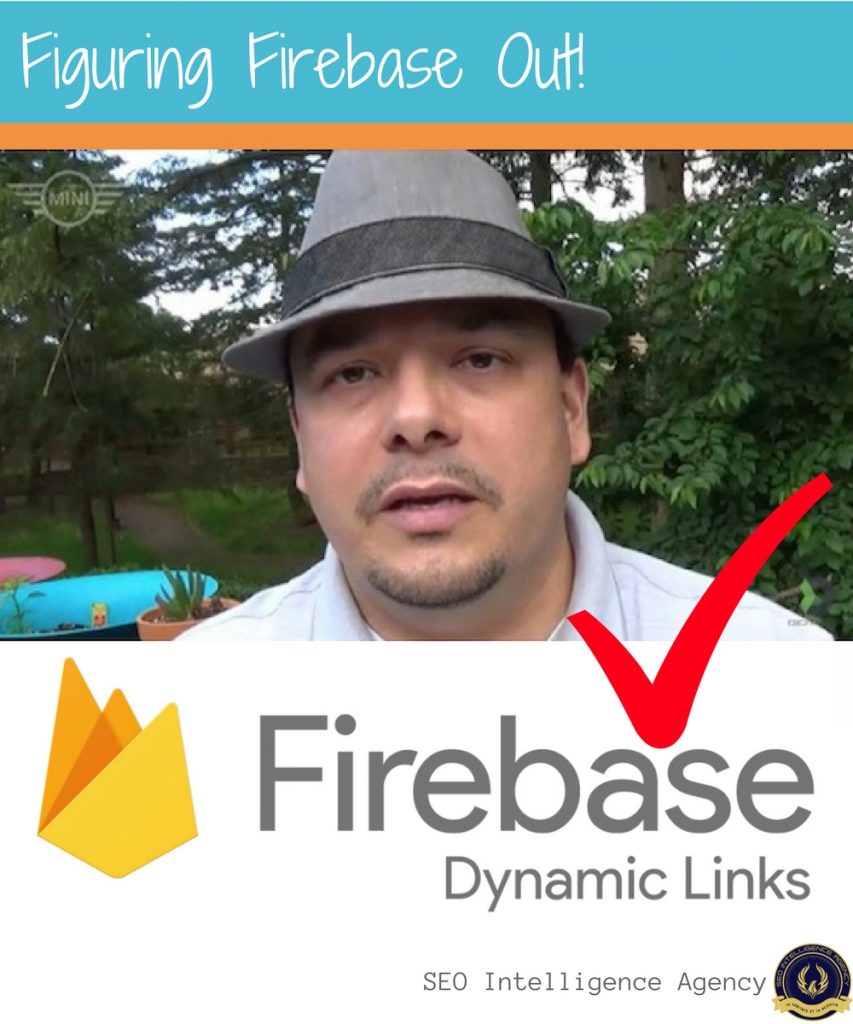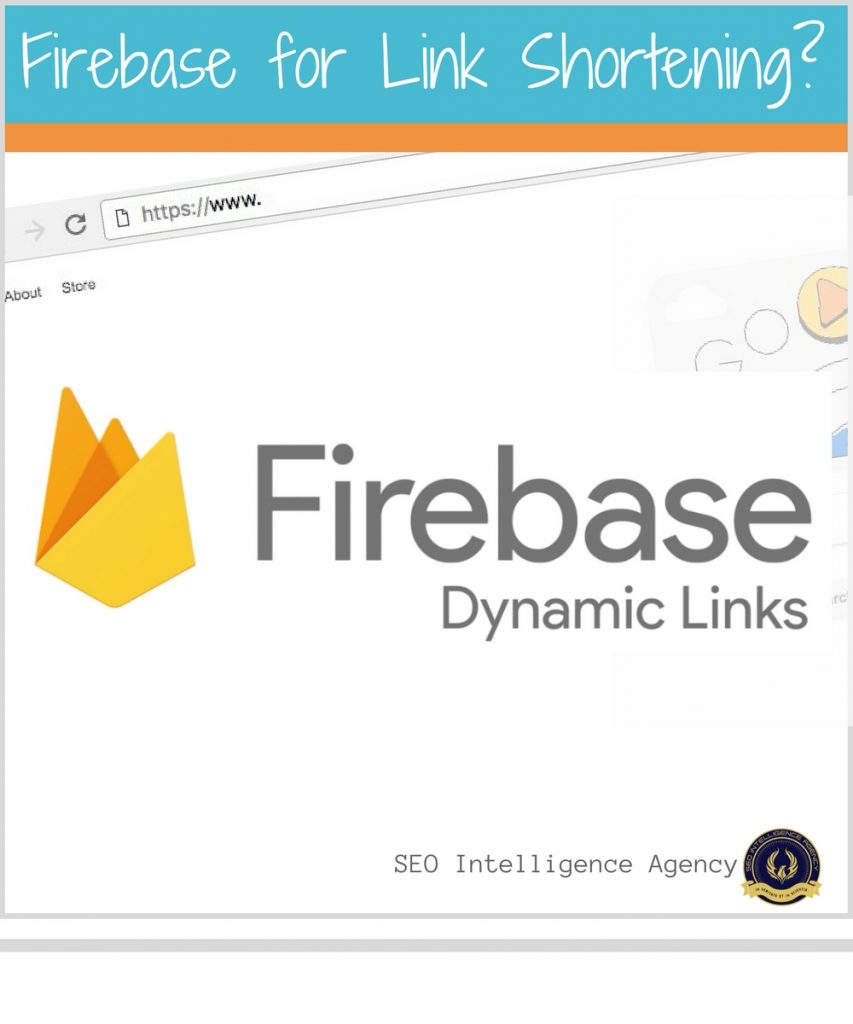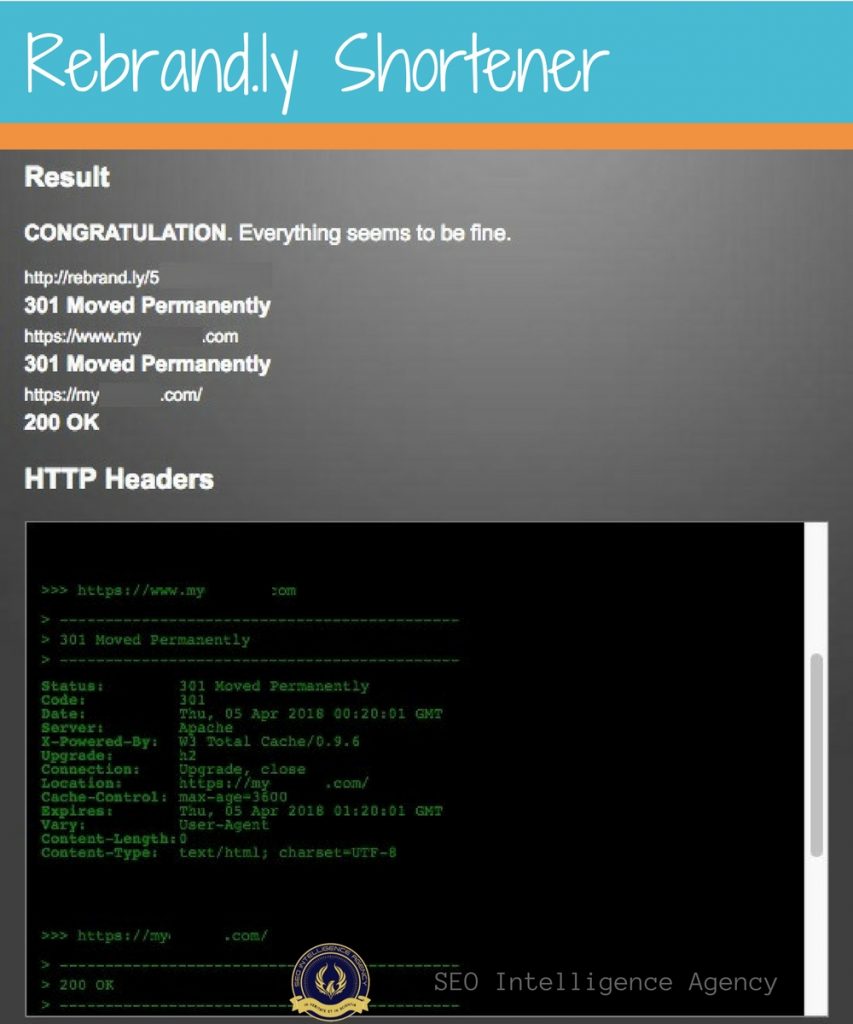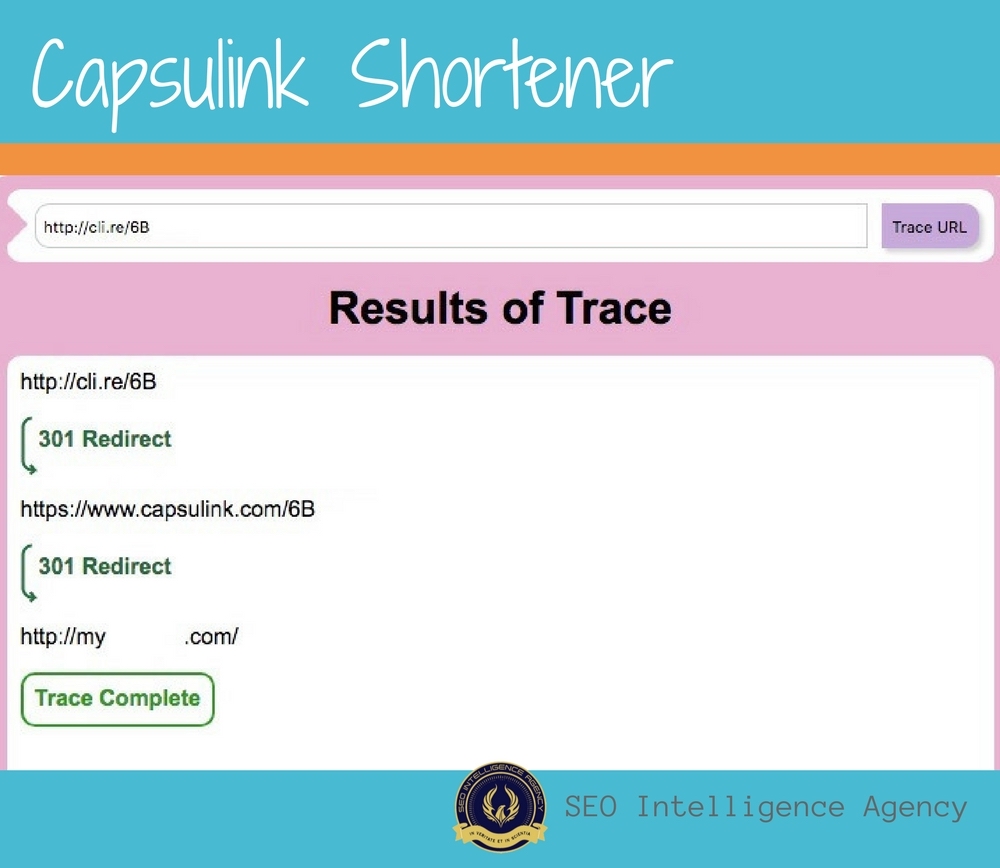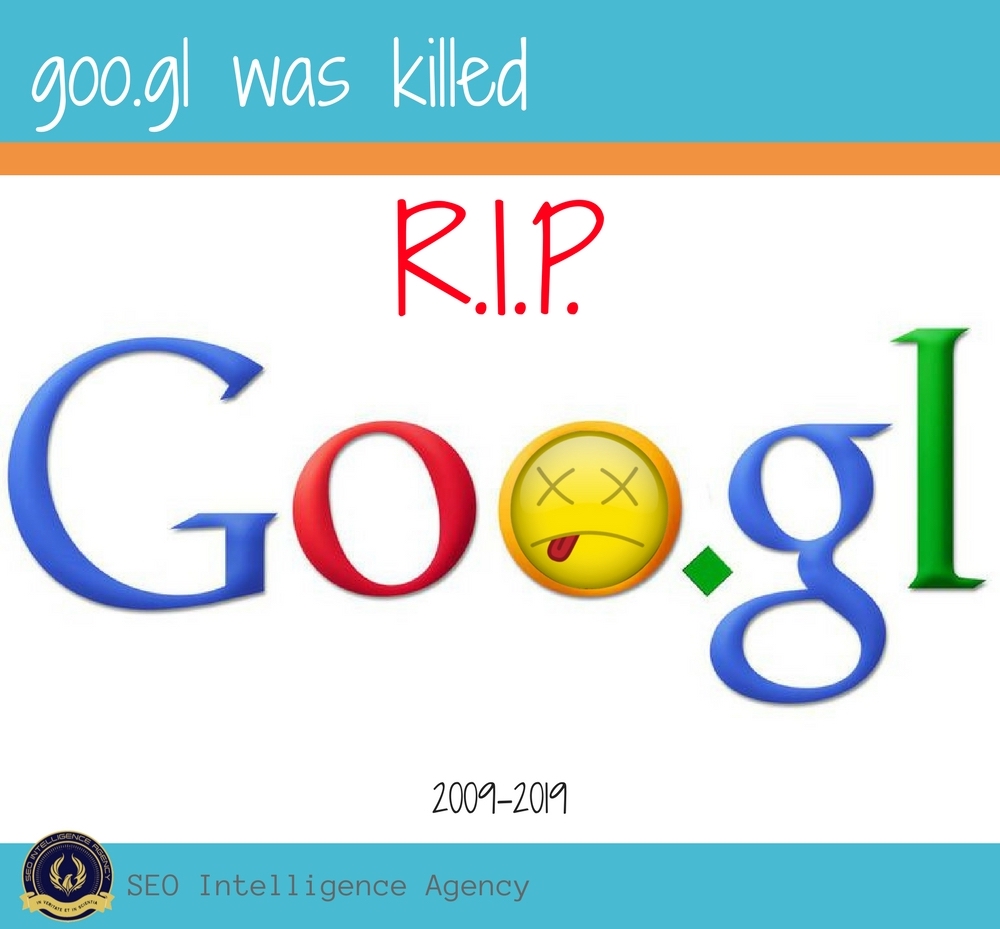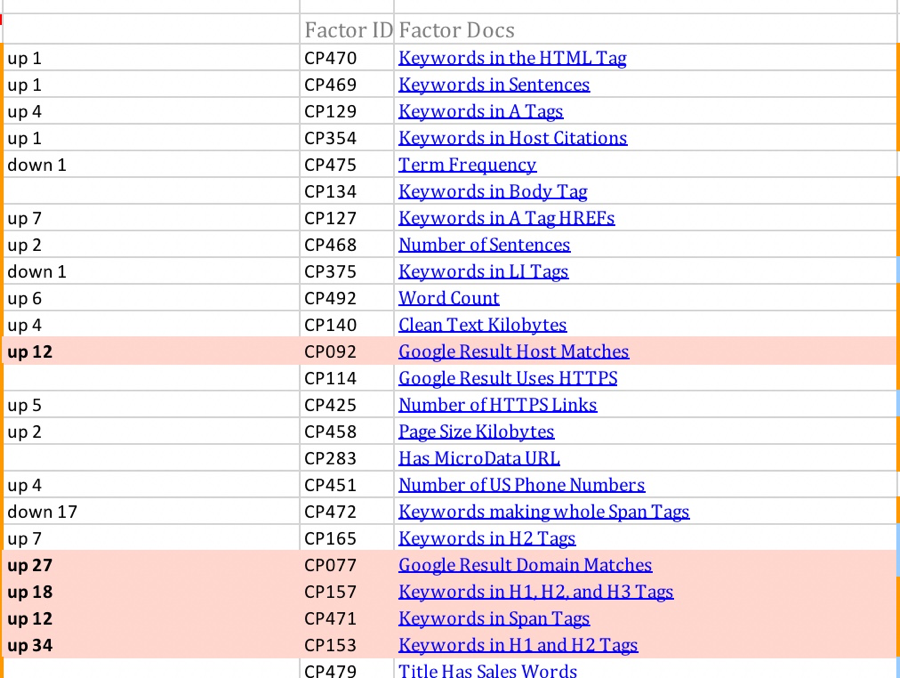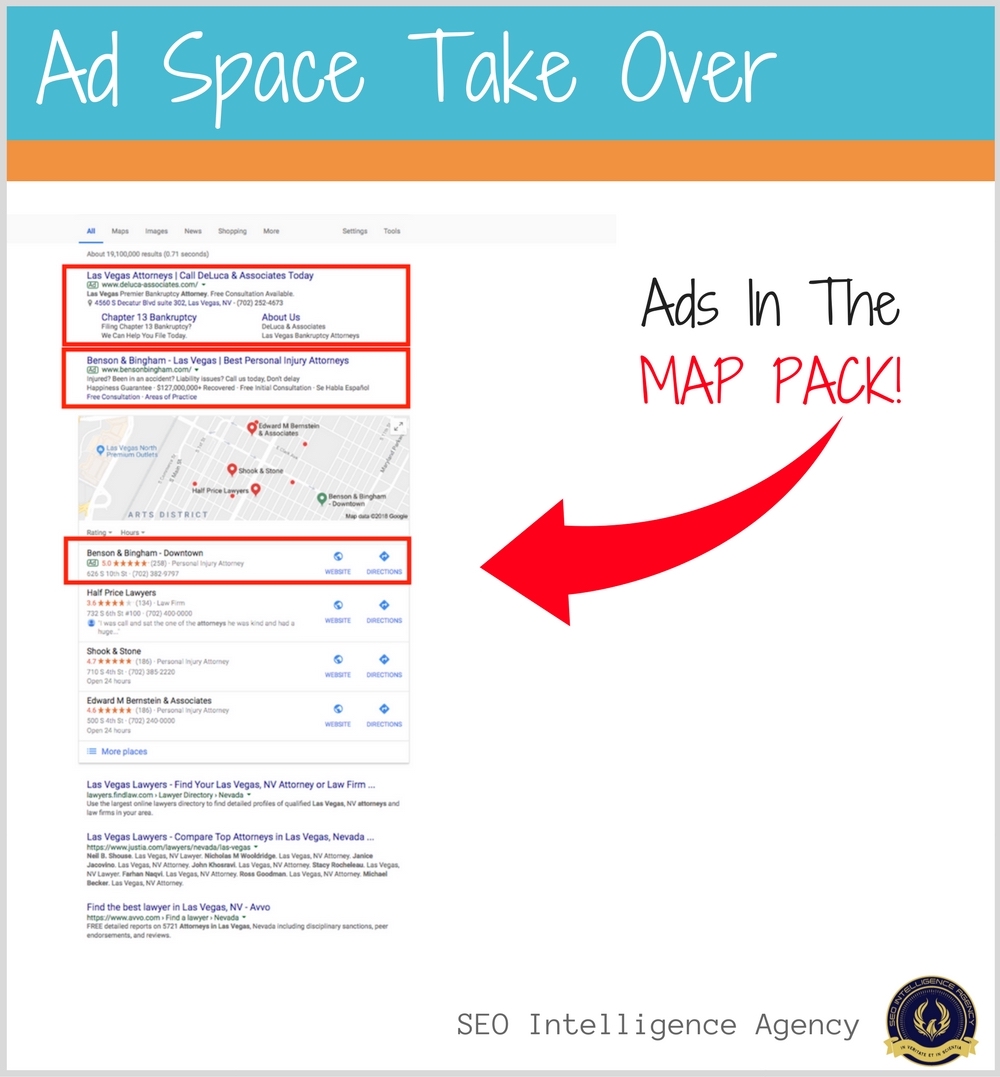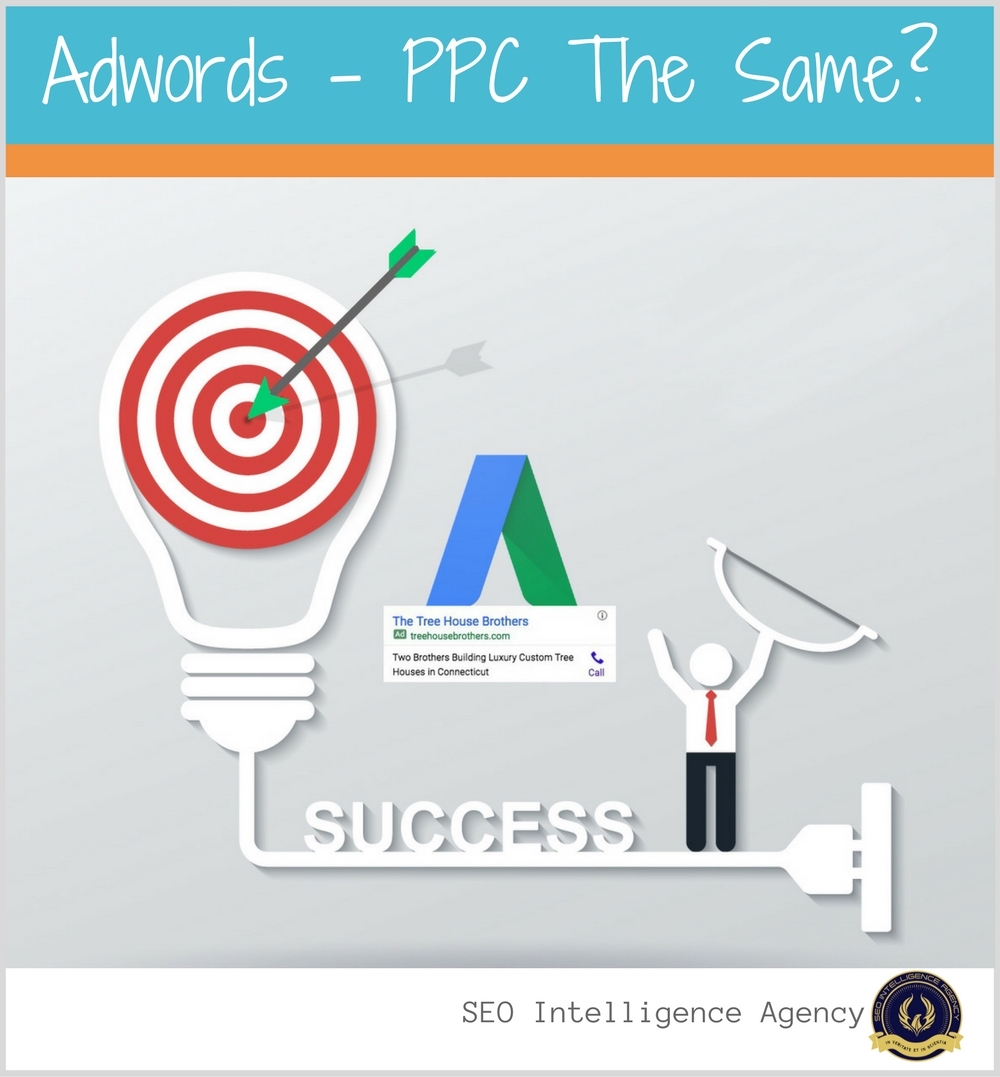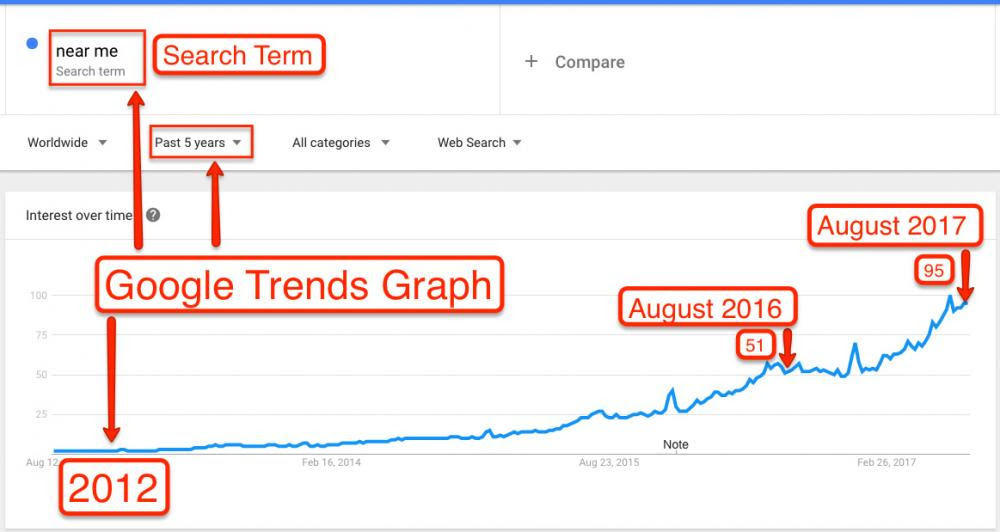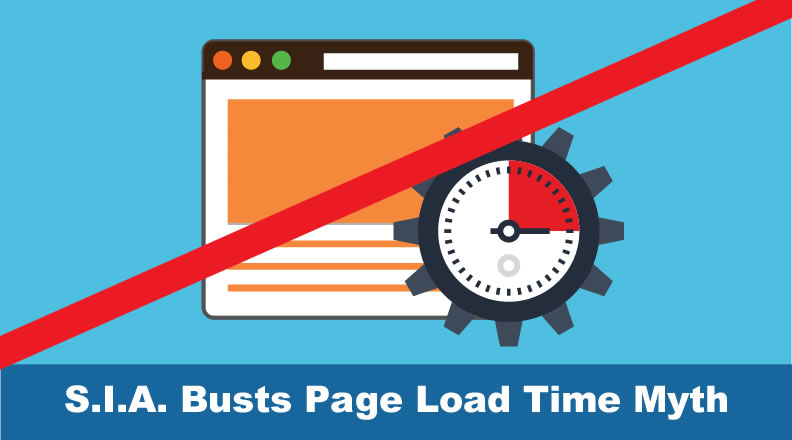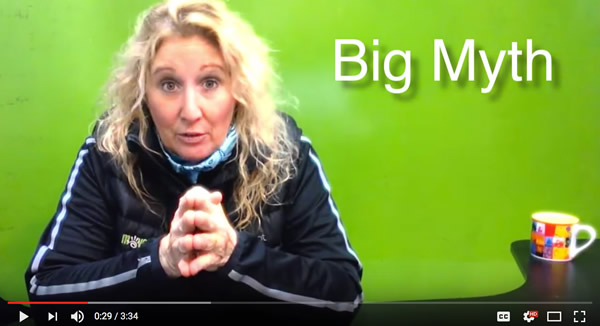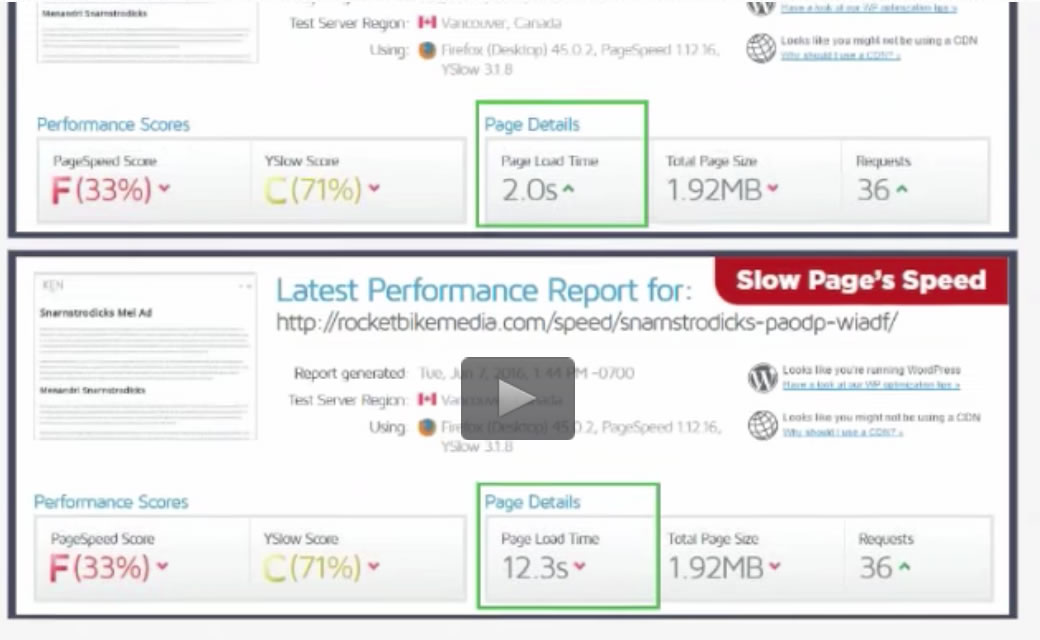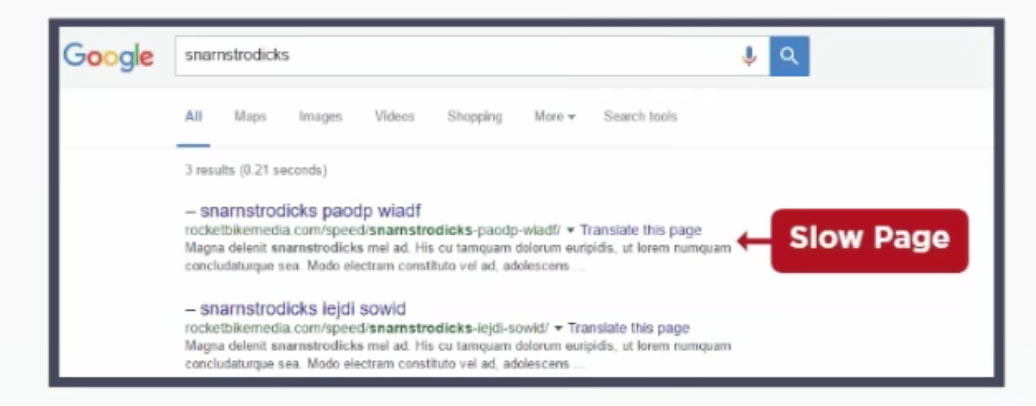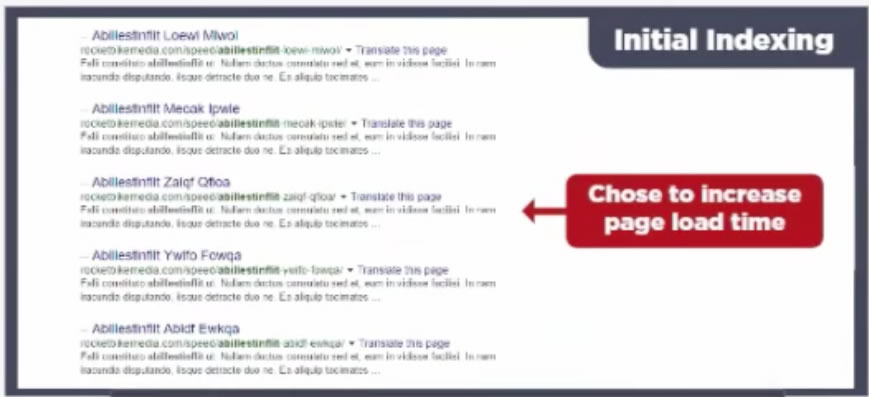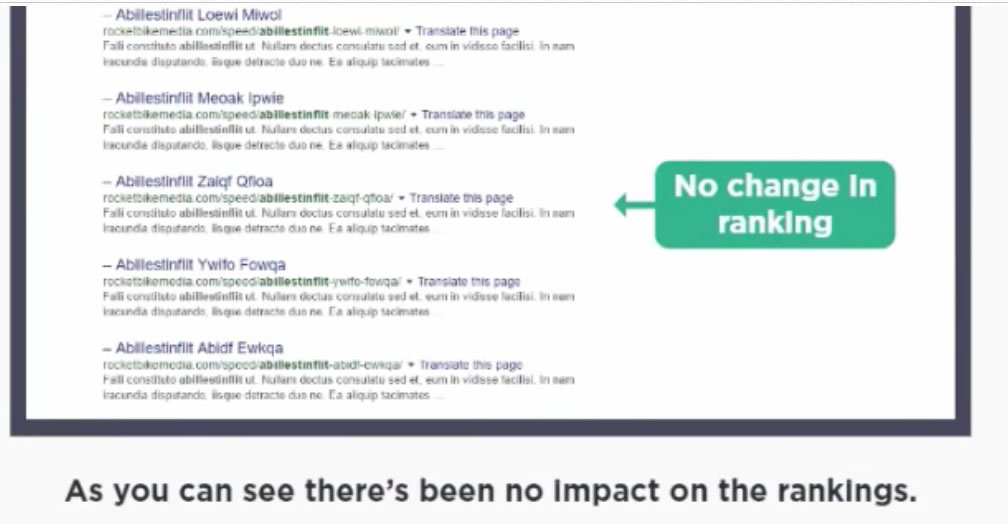The myth that Google cares about Domain Age, Domain Link profile, Domain Spam hublot replica level, and TLDs have SEOs wasting a lot of money on links that aren’t as powerful as they could be.
I said ENOUGH! I’ve been building successful link networks since 2003. I know link building in and out. I just didn’t buy into Google using Domain Authority as a ranking factor.
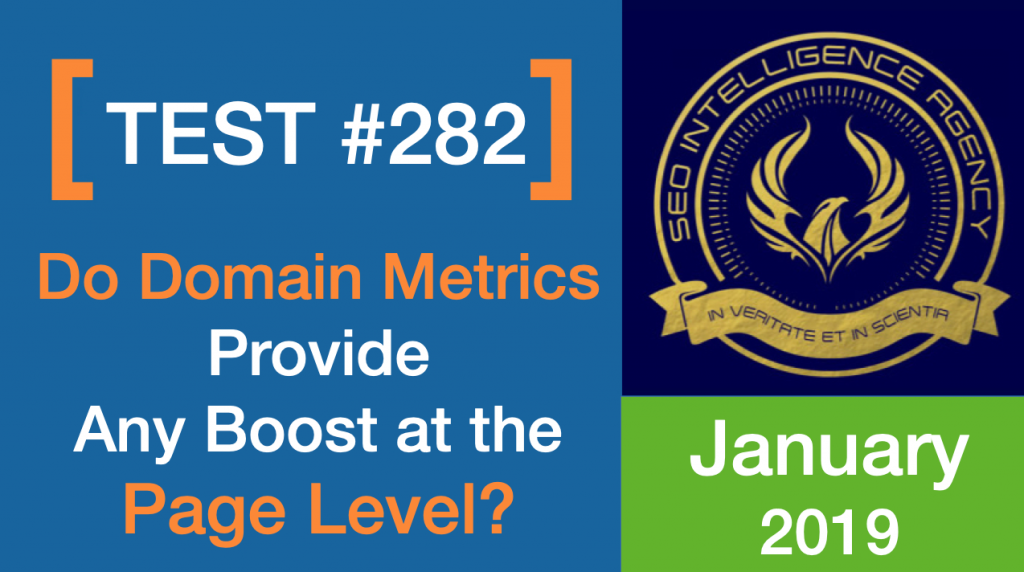
We decided to put it to the test.
This test proved what I already knew. Domain Authority really isn’t a thing. Domains don’t have any inherent authority. What we often attribute to Domain Authority is actually the linking between pages that have authority. Authority is definitely at the page level.
The test idea is simple. If we create multiple test sets and Domain Authority IS a thing, these test sets should start to rank in an orderly fashion.
If these domains have different values attached to them, then the test pages should start to rank in the same order that we build them.
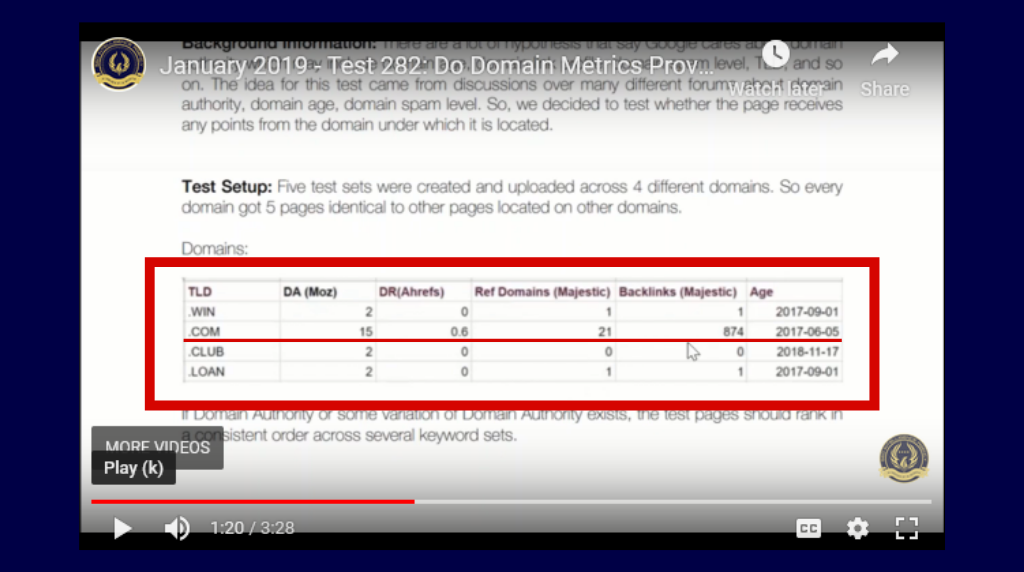
You can see that the .com should be the clear winner here. It has a Moz DA of 15. The rest have a Moz DA of 2.
We tested a .win, a .com, .club, and .loan.
The .com has 874 backlinks where the rest have 0 or 1 backlinks. If there is some sort of Domain Authority, the .com should be at the top christian dior 27466 fashionable slippers of each set every time.
For the others, there is nothing that distinguishes them because they are all around the same “authority”.
Or you could argue that there will be Domain Authority attached to them. The domains attached to those backlinks are all different.
The .club is the only one without any backlinks so that should come out on bottom. The .com should be at the top if Google cares about Domain Authority.
The .com should be the winner but it isn’t consistently at the top. In fact, in the next set, it drops even lower. And it isn’t near the top.
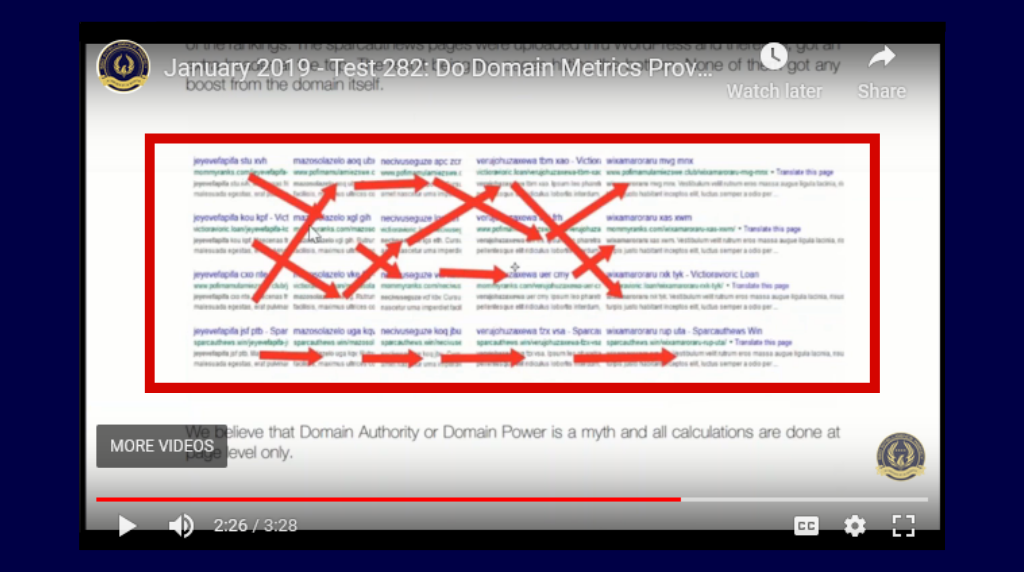
The only consistency is the .win at the bottom every time. It was the .club that didn’t have any linking domains. In one of the sets, the .club was even at the top!
This test confirms that the domain itself isn’t the thing carrying the authority. Domain Authority definitely rests in the pages itself and how those pages are linked together.
Just the domain itself, having a particular Domain Authority isn’t being passed to the fresh page.
So what’s the point?
A lot of people sell links on high DA domains and are using that DA metric as a selling point. But the reality is there is little benefit, in itself, to having a link from a high DA site.
Instead, you should be looking at how well the internal link structure for that site is set up in order to determine how much link juice is going to be passed through that backlink.
For example, if you get a link on a DA60 site and the article is linked from the homepage, great! You probably have a valuable link.
But if you are getting a link from a site where your article is buried inside the blog somewhere, there isn’t much value to that link.
I discovered something powerful. When I linked my pages in a very specific way, that powerful link juice flowed through the site. This is how I create my link networks.
]]>
We’ve seen an exciting year in SEO. Our very own Kyle Roof went head to head with other experts in an SEO ranking competition. He was the talk of the competition when he dominated using Lorem Ipsum text. The S.I.A. continued to expose what was scientifically needed to rank a site in Google.
The S.I.A. has continued to grow by leaps and bounds since we first began four years ago. We now boast some of the brightest minds all working at taking the mystery out of the Google ranking algorithm.
Our members are testing exactly what Google wants, and coming up with some startling answers.
Our best SEO optimization experts are committed to ranking and helping other people rank.
SEO facts not SEO guessing.
We’ve chosen these SEO experts because they continue to crack the Google ranking code.
So…
How’d you like to see our secret authority experts and resources to blow past your competition?
Today is the day that we offer you a rare peek behind the S.I.A. curtain…
We are sharing some of our absolute BEST sources with you.
Warning: Many of these names may be new to you. Some of theses names have risen to fame. All are part of the secret underground elite.
In true Dori Friend style… you won’t read about Rand Fishkin or Brian Dean here. No matter how much of a big deal Neil Patel is you won’t find him on this list either.
You WILL learn about people that you probably don’t know or may have not heard about.
These influencers are part of an SEO network that has been turning Google on it’s ear. They are keeping one step ahead, while letting the mass SEO guessers get hit with the Google algorithm smack downs.
But today… I am going to reveal our SEO influencers…
So you can follow them.
This is for my list only…
Follow them and learn their tricks.
Because you never know when or where they are going to drop their next golden nugget.
S.I.A. Influencers for 2018
Special Mention: SEO King of the S.I.A. is Bill Hartzer – Bill Hartzer is an SEO and Domain Name Consultant, based in the Dallas, Texas area. He provides technical SEO audits to clients, as well as ongoing monthly SEO services, as well as domain name consulting services. Flipping domain names, PBNs and being quoted on some of the biggest SEO channels online, Bill is ahhhhmazing. He hosts the super popular weekly SEO Podcast for S.I.A. members. If you aren’t a member, you’re definitely missing out on some amazing SEO and business building tactics.
www.hartzer.com
twitter @bhartzer
https://www.facebook.com/billhartzer
Clint Butler – As an Army veteran, 21 years in with three deployments to Iraq and Afghanistan, Clint learned real world applications of problem solving and adapting quickly to change. He is the Head of SEO for Over The Top SEO and owns his own agency. He is the host of SEO This Week and has co-hosted other SEO podcasts. He runs an exclusive mastermind for six and seven figure earners looking to reach the next level in their business while supporting others. Clint regularly presents at SEO Rockstars and SEO Spring Training. He has created beginner and advanced SEO and marketing courses which taught concepts based on his affiliate and adult industry experience. Clint has one of the brightest (some say devilish) minds in SEO.
https://www.overthetopseo.com/
https://www.digitaleer.com/
Ted Kubaitis – Ted Kubaitis regularly appears on the White Hat Versus Black Hat youtube show and speaks at SEO conferences such as CMSEO, DMSS, SEO Rockstars and many more. Ted has founded multiple startups and was issued a patent in web querying technology.Ted came into the S.IA. hot with some SEO Mind Bombs and he hasn’t cooled off. Creator of the SEO software Cora, Ted is continuing to be a dominating force in the SEO world. He joins Clint and Kyle in a popular weekly Youtube series called SEOFightClub.
https://seotoollab.com
http://seofightclub.org
Jeff Lenney – Jeff Lenney is a full time Affiliate Marketer, SEO Expert & High End SEO Consultant. He lives in Orange County, CA, with his wife and 2 kids and is currently working for himself full time in order to support his wife’s Disney Habit. Jeff has become the lethal weapon with SEO and Launch Jacking that you want to know. He started an affiliate site in 2018 and shared every step of his process inside the S.I.A. and it has boomed. Jeff is a wealth of knowledge.
https://JeffLenney.com
Bory B – Constantly testing, Bory adds a depth of information to the Skype conversation. He isn’t afraid to ask questions and jump into conversations to share what he knows. He is a big part of the S.I.A’s underground elite and wishes to remain anonymous to the general public.
Craig Ramsay – Craig Ramsay is a digital marketing consultant based in Edinburgh, Scotland, focused on a “many hat” data driven approach to SEO for local and Ecommerce clients.Joining us in the first quarter of 2018, Craig has been a valuable asset to our Skype group discussion. He’s always quick to jump in with tool recommendations that solve unique SEO issues.
https://www.shakedigital.com
https://www.facebook.com/ramsay.craig
Terry Power – Terry surprised us all. He came in quietly and soon made a huge splash and became one of the guys that everyone listens to when he speaks. As a speaker at the 2018 SEORockstars event, people really got to see the brilliance behind this great and humble man. Since presenting at SEORockstars, Terry has been continuing hs Cloud research, developing a method of misusing some of them for increasing CTR and continued to pass on knowledge to others in the SEO community. He also has his own very popular Mastermind group where he helps people take the Ranking Factory software to the next level.
Facebook.com/GoogleGuy
https://TerrysTipsandStrategies.com
Michael Chrest – Michael Chrest discovered his passion for internet businesses in 2002, having bought his first online business from a friend. He then began his first web design business and discovered the power of SEO. After years in the business, he decided to focus on helping other businesses grow and succeed online. Never afraid to rock the boat or inject humor, Michael offers a fresh and knowledgeable perspective on many SEO topics.
https://www.calgaryseocompany.ca
Todd Weeks – Todd Week’s passion for Mentoring, Marketing, and Storytelling has helped guide his career from Social Media Technologist to Video Production & Director, Educator, and Blogger. He currently manages growth and direction for 2Surge. Known as the man when it comes to AWS and Route53, he has helped many people who are stuck with hosting or even getting emails to inbox. He always gives tons of value to our S.I.A. members.
https://2surge.com/
Twitter: 2surge
Chris Jeffry – Truly valued for his insight, Chris has both asked valuable questions and offered valuable answers to other’s questions. He accidentally stumbled into SEO in 2016 and it’s officially replaced his twitter addiction. Coming from the finance and data analytics world, he brings a technical, data-driven approach to learning SEO while building a portfolio of sites. He’s your guy for any and all Excel geekery. He’s a strong member for the S.I.A. and another member that likes to stay underground.
S.I.A. Rising Stars for 2019
Mr Sir
Benjamin Killingsworth
Alex M-W Maggs Wellings
Suzy Bloomfield

Make sure to look for this badge to know if you are following an SIA Influencer!
When Google announced that they were ending support for its Google URL Shortener at the end of March 2018, it became the talk of the SEO circles.
“Starting April 13, 2018, anonymous users and users who have never created short links before today will not be able to create new short links via the goo.gl console. If you are looking to create new short links, we recommend you use rolex datejust mens 40mm 16234 black dial Firebase Dynamic Links or check out popular services like Bitly and Ow.ly as an alternative.
If you have existing goo.gl short links, you can continue to use all features of goo.gl console for a period of one year, until March 30, 2019, when we will discontinue the console. You can manage all your short links and their analytics through the goo.gl console during this period.”
Even though Google won’t be completely phasing the tool out for another year, SEO experts like Clint Butler jumped in with finding the best way to deal with the news.
The Best Alternatives to Google URL Shortener
You can do a couple of things, go create a few hundred goo.gl links before April 13 or as Clint puts it – since Google was nice enough to give us this Firebase thing to play around with, maybe we can find some cool to do with it.
Firebase isn’t a shortener. It has dynamic links for mobile apps, nothing in the way of a link shortener.
While Google suggested bit.ly as a shortener, our tests showed that bit.ly links passed the least amount of juice. But we also know that Google’s suggestion is not surprising.
Clint figured out Firebase and link shortening. When you go and it asks for app details, just put in random information, it doesn’t verify.
Then when you create the Dynamic Links, it will give you the option to make the links open in a web browser as default, keep that.
Just so you know, the redirect cheap alexander mcqueen is a 302. Testing will determine if they are effective to use for links.
Other uses of Link Shorteners
Instead of using them in stacks or to blast links at, URL shorteners make link sharing cleaner, easier, trackable and manageable when using them on social media platforms.
Using link shorteners are easier if you cannot hyperlink your text.
Imagine this link:
https://maps-apis.googleblog.com/2018/03/the-real-world-as-your-playground-build.html
reduced to
https://goo.gl/mapz
The shortened link is much easier to type (and remember) if you need to.
While a few URL shorteners simply turn long links into short ones, others allow you to customize the link with your own text. You can track how many clicks your link has and even be able to analyze those clicks.
Almost all the link shortener companies have a free tier and paid tiers. If you want more data and analysis, you will need to upgrade.
We break down 2 Link Shorteners that are simple to use and could be a better choice than bit.ly or owl.ly
The 2 Best goo.gl Alternatives
- Rebrandly
- Capsulink
Rebrandly
Once you signup for a free Rebrandly account, you’ll find it is pretty much like all the others.
It’s focus is on custom links for branding and awareness. You could take the Harry Potter Wikipedia page and name it HarryPotter/Wikipedia or JKRowling/amazon-books could be used as a direct link to the author profile on Amazon.
You get 1,000 links on one domain for a free account or splurge for the $19 a month and get 3 domains and 10,000 links.
Rebrandly is a 301 redirect.
Capsulink
Capsulink makes signing up easy since you can sign up with your email, google or even facebook. You have a choice to create your first short-link or import bit.ly links. There are so many uses for this!
Capsulink comes with a 14 day free trial and plans start at $24 a year. You get an editable shortened URL, 1 custom domain, plus 3 Smart URLs per short link.
In our tests so far, Capsulink gave the most link juice, but you should be aware that…
When you create one of their shorteners there are a couple “redirects/hops” that occur for the shortened link. If you put that url in http://redirectcheck.com/index.php you will see that there are several hops that occur. You can bypass the hops by entering the long version of that shortener https://www.capsulink.com/whateveryourendis
The Demise of Goo.gl and What It Means To You
If you have used goo.gl while you were signed into your Google account, you will have a year to continue to use it before you will be cut off. The links that you currently have will continue to work.
Why Was goo.gl Killed?
We’ve seen Google services come and go. When Google kills off the services we use a lot, it’s frustrating. However, Google is moving people towards dynamic links.
We are even seeing Dynamic URLs in Google Adwords. Instead of mourning the loss of goo.gl, get on board with dynamic links because all signs are pointing to Google giving preference to these.
What Are Dynamic Links?
Big Brother has been created into a link. Kidding. Sort of. Dynamic Links change depending the habits of the person that clicks them. The idea is that the internet will become more fluid. Fluidity is needed with people bouncing between computer, mobile apps, native apps, IOS and Android.
You own an app on your phone. You click a link. Your link opens that part of your app up that you want to see. If you click the link but don’t have the app, you will be directed to the download page. The links will also be built to know if you should be directed to an IOS download page or an Android download page.
Dynamic Links allows various situations to be built into the link to cater to the user for a faster and better experience.
Should You Switch To Dynamic Links Instead of Shorteners?
It’s still too early to tell, but we can see that Google is forging ahead in that direction.
Firebase is a owned by Google and is a dev platform for mobile and app creation. Without further testing, we don’t know yet the impact the dynamic links from Firebase can have.
To create a restrictive experience rather than a fluid one, a URL shortener gets the job done just fine.
Don’t rule out Firebase as purely for app devs. You know we will be testing this one!
**Special thanks to Clint Butler for being forward thinking and focused on figuring out Firebase’s Dynamic Ads.
]]>Skype Chat Summary
March 28-30, 2018
TOPIC: Google Algorithm Changes on Local Results?
- Bill Hartzer: Anyone care to check a Google search result for me? Seo consultant. I’m seeing my LinkedIn on 1st page
- Clint Butler: showing local results
- Holly: ps://www.entrepreneur is my 1st
- Bill Hartzer: yeah I see local results also… But main results I’m seeing sites from all over… Washington, houston, Michigan. First time I’ve seen Google identify a LinkedIn profile as “local”.
- Holly: this is just a huge mess. U cant gauge anything

- Bill Hartzer: yes, it is a mess. Seems as though it’s more personalized than before. Especially with more results not even showing or being indexed in certain data centers
- Holly: yup I have people in a private group from bootcamp, 6 of them see a certain serp from a test, but I don’t. And its all over the place, phoenix, NC, LA, WI. It’s like I’m hitting old data centers. My phone pulls it too which is connected to my wifi
- Bill Hartzer: Maybe they’ve tagged your IP? I’d reset all the modems/routers in the house to see if you can get a new IP.
- Holly: i checked on 3 vps too same
- Bill Hartzer: logged in?
- Holly: no i never log in on them
- Bill Hartzer: definitely something going on.
- Devotech services: even if I search in google.com “seo consultant ” local results take precedence. Without login as in private window
- Bill Hartzer: yes, it looks like that way, even in incognito mode. But what I’m seeing is LinkedIn profiles starting to show up for local phrases. This is the first time I’ve seen a LinkedIn profile show up for a local search keyword. So Google is seeing the location of the person’s LinkedIn profile and associating that with a location. I have not looked to see if LinkedIn is using any schema to try to influence that.
- Devotech services: I don’t see any result from LinkedIn.
- Bill Hartzer: any cities will show that… New york seo consultant, dallas seo consultant, etc.
- Devotech services: i am seeing now results are little tricky. They track ip. Even if i search in Google in different country. They show the local result only. Does not show me any result from usa cities. I tested with 2-3 different ip. Earlier it was not like that.
- Bill Hartzer: OK, it must be more local then. All major cities in USA showing the LinkedIn contractors page, and some LinkedIn profiles.
- Devotech services: which city?
- Bill Hartzer: dallas but new york also showing this
- Devotech services: I am not seeing the same result. One question does browser version also has any role to display result ?
- Bill Hartzer: not unexpected, as you are probably seeing another data center. Some locations just don’t show the same results. It’s the data center you access.
- Devotech services: so user can not control which datacenter they choose? In one city do they have different datacenter or only one?
- Bill Hartzer: there are lots of data centers, you don’t know which one you are connected to. Sometimes it changes
- Devotech services: seems global seo going to be very challenging. Is it not the Google can display data based on this by default settings in search ?
- Bill Hartzer: I am not sure what they are doing now, it has changed in the past few weeks.
TOPIC: Quick Tips – GMB Listing, Adwords, Post Category Naming, Maps
- William Twiner: for ranking is it better to have /service/service-name or would /services/face/service-name bother. I think I remember a test in e-commerce where it’s better to have to so many deep categories?
- Ryan Hough: Based on our early tests if people use service or services when they search then its best to have it in the url – if not its best to just have the name
- Bill Hartzer: you can now add your business description to your GMB listing… Another chance to keyword stuff it. YAY!
- Devotech services: just saw they have added messaging system as well
- Kyle Roof: off topic and not sure if it was mentioned the other day, but adwords announced that starting April 29th they will put ads into your ad groups “to make them better”. You’ll have 14 days to review the suggested ads, if you don’t opt out, they will put them in for you. Just a heads up for you adwords folks. I’m confident that their interest is in making your campaigns better and has nothing to do with them making more money.
- William Twiner: when you link to GMB, what are you linking too? The URL Google gives you when you want to share your map?
- Michael Chrest: i use a variety, shorted link from share button, review links form share on reviews. Driving directions link. All kinds.
- Michael Chrest: How is a post treated compared to page? Is there a difference in terms of SEO?
- Jeff Lenney: If you’re not doing a silo with it, no. Both need the same on-page treatment. THOUGHT – pages tend to be more dominant (about us/ contact/ faq’s etc) so make sure you add internal links FROM those as well, as they can be quite powerful
- Michael Chrest: My competitor is using an interesting map trick. Http://zrr.ca/apple-app-site-a
ssociation . His hundreds of parked domains all have his NAP and link to his site on them - Bill Hartzer: are those embedded maps or just links NAP and links? Sorry, didn’t look at the site
- Michael Chrest: no just NAP and Bare URL. Parked. Not sure the SEO value but for unstructured citations it woks well.
- Michael Chrest: How can you tell if Gshortener is a 302. Https://goo.gl/maps/caibcypprm
v . Like this- Bill Hartzer: do a server header check or use Google developer tools to see it
- Michael Chrest: Google added share buttons to all url links on GMBS. There are so many links to share on a GMB
- Jeff Lenney: it’s both. Http://redirectdetective.com/
TOPIC: John Mueller AMA on Reddit
- Bill Hartzer: BTW, John Mueller is doing an AMA over at Reddit today. I’ve asked a few questions. Ted, I’m sure you have some technical questions, as well
 https://www.reddit.com/r/techs
https://www.reddit.com/r/techseo/comments/87pxsu/i_am_john_ mueller_webmaster_trends_analy st_at/?St=jfbfew1h&sh=41f08063 - Ted Kubaitis: It will sound like a stupid question but I think “How important is repeat visitation for ranking well?” Its a loaded question and if he gives any detail at all it may be quite important as to why human CTR influences rankings but CTR bots do not. In the past he has expressed knowledge in this area too… So if he plays dumb on the topic it will contradict his past tweets. He may squirm a little when you ask it.
- Clint Butler: Dropped a question on the AMA for John. Https://www.reddit.com/r/techs
eo/comments/87pxsu/i_am_john_ mueller_webmaster_trends_analy st_at/dwfouo3/ - Bill Hartzer: well yeah… Just ran into it today where an SEO disavowed only on the current resolving version of the site. But when I looked at the other versions there were different old disavow files for other versions of the site. Had the SEO updated the disavow on all versions he would have seen the old disavow files on the other versions
- Clint Butler: In my opinion, I pull the links from all the versions and then go through them. The disavow is built, then I only put it up on the true version of domain in SC. I don’t upload to all of them.
- Bill Hartzer: I pull all links–then upload same file to all of them. I’m more thorough, I guess but then again I just deleted my disavow file on my site so what do I know.
- Bill Hartzer: From John Mueller today: (yeah, he answered MY question):
Q: Regarding disavow files: Do you need to verify all versions of your site (http, https, httpswww, httpwww) in Google Search Console and upload the disavow file to all versions of the site?
A: No – a disavow is between two canonical urls essentially. If the https://www version is the canonical for your site, that’s the one where the disavow is processed. (Caveat – sites with bad canonicalization can have pages on various versions, so if that’s the case for you, I’d just upload the same file on all of the indexed versions while you get those rel=canonicals fixed :-)).
- Clint Butler: John’s response to my question: “I’d generally focus on the more scalable & normal ways of getting content indexed & updated, rather than submitting them manually. TBH I’m kinda surprised so many people do that manually when the normal processes should work just as well – save your time, just make sure your CMS uses sitemaps & pings them properly.
Regarding datacenters: yes, we have a bunch of them, and sometimes you can see differences across them. That’s kinda normal and has been like that since pretty much the beginning. Usually that settles down on its own though.”
Kind of what of what I expected, its the same “if you build it, they will come, eventually” mentality.
TOPIC: Changes in SERPs Behavior – Google Algorithm Update?
- Ted Kubaitis: Seeing 20 place swings in Google rankings on my calibration sites. I don’t change my calibration sites in any way… For years… Either I rolled a Google experiment server or something big is going down.
- Clint Butler: are they mobile friendly lol
- Bill Hartzer: yeah that’s my first thought
- Ted Kubaitis: Yup… They were ranking 11 for very high value keywords… Used to shifts of 1 or 2 spots. Now bottom of page 3.
- Bill Hartzer: Then there’s definitely something that G doesn’t like about those sites.

- Ted Kubaitis: Sigh… This is the site I don’t SEO…. It’s just for calibrating my tools. LOL … That’s a big fail on Google’s part if all my spammy shit passes and these fail.
- Joel Mackey: We’ve seen the same with one of our top sites. It was ranking #1 – #3 on many high value keywords and we’ve dropped 20 – 40 positions this last week. It’s in the edu area. Pretty wild as we’ve held these rankings for nearly 10 years. :E
- Clint Butler: old sites, never updated, Freshness maybe?
- Bill Hartzer: Shouldn’t you be able to isolate the factors that are affected, Ted? Seems as though Cora should be able to do that fairly easily. Unless they’ve introduced new factors that you’re not tracking?
- Ted Kubaitis: Hopefully, but again I don’t SEO these sites… I need them to remain constant so I know future builds of Cora are counting things correctly. More important than rankings…. Just shocked they took a hit. I guess I shouldn’t be… They are the most white hat sites I operate. OF COURSE those are the ones that tank. LOL.

- Bill Hartzer: True, but can’t you just run cora again and look at the numbers to get any indication of what changed?
- Ted Kubaitis: Probably also means that the before and after update analysis we did last week was premature. Google probably wasn’t done rolling things out. I plan too… But I am coding currently.

- Holly: did it move or they are just tinkering with the data centers. If u refresh it I bet it will come in somewhere else
- Ted Kubaitis: Cora nukes cache and history on every run. Some believe that if you get drafted into an experiment it recalls you by canvas fingerprinting to keep you in the experiment.
- John Owens: This type of stuff has been happening to me for the last 6 months or so. Capture.JPG. I have plenty of examples of this. We didn’t make any changes…we just waited it out and it came back. Seems to be on a 30 day cycle when it happens
- Ted Kubaitis: Maybe they are hunting for seos… Trying to trigger a response.
- John Owens: those are always fun calls because they are in a panic and I say there is nothing we can do but wait. That really puts their trust in us to the test. I have tried making a bunch of changes and it made no difference
- Joel Mackey: Complete flux across the board. These rankings are today vs last night at the DMA level on mobile. First column for each DMA is current rank, second column is change compared to last night.
- We normally see extremely stable positions and if anything moves it’s 1 – 2 positions. Things are getting a bit whackadoodle.
- Ted Kubaitis: My ranking is only messed up in the US… Ranking if fine in Canada.
- Holly: did you guys figure out why something is ranking in some locations while its not like in seattle. When I’m in the wis. Is it data centers?
- Bill Hartzer: John Mueller answered that yesterday on his AMA. Question: We are seeing evidence of data centers not consistently reporting sites in the index. While not an issue for a local site, a national site could negatively be impacted by this. What is happening, as an example, is a page is getting indexed in the East coast data center and the west coast data center is showing it not in the index. We have seen examples of this consistently. Again, what is happening with indexing and crawling the internet that is causing this new behavior on Google?
Answer: Regarding datacenters: yes, we have a bunch of them, and sometimes you can see differences across them. That’s kinda normal and has been like that since pretty much the beginning. Usually that settles down on its own though.
- Holly: yeah but how do we don’t what is right and what isn’t. I see the results on my phone but I see completely different on my laptop. Laptop are the same as 3 vps. So which fricken ranking is right?
- Bill Hartzer: yeah that’s the mobile first at work. I ‘d be the mobile is “right”
- Ted Kubaitis: More on my ranking situation… The sub page is not ranking anymore and the homepage is now ranking at the lower position…. A clue there. And here are the correlation diffs from the past two days:
It is like Google just revved up the juice for emds/pmds and people tuning headings. I’m doing neither on my calibration site. Or maybe some sort of legacy limit has been removed?
- Jeff Lenney: so add MORE header tags etc now? Interesting results for 2 days span
- Ted Kubaitis: well… More keywords in header tags… Two days ago was bottom of page 1… Now middle page 3… Over the years this website has moved +– 5 spots… First big dip I’ve ever seen on this page. Every keyword is different and if you are heavily tuned in headings now adding more might not be beneficial. Best to measure.
- Holly: https://www.seroundtable.com/g
oogle-march-28-update-25488.ht ml
TOOLS/SERVICES MENTIONED:
- Devotech services: nice plugin. Https://wordpress.org/plugins/
fitvids-for-wordpress/ - Rex Freiberger: is there a tool or software someone recommends to rebuild the content from an expired domain? I have a lot of Google cached content I want to pull and rebuild… I was looking at waybackmachine but not a lot of content was snapshotted it seems…
- Kyle Roof: http://www.screenshots.com/ They might have something for you
RESOURCES/GOOD READS:
- Todd Weeks: Correlating ranking factors for youtube serps: https://www.briggsby.com/rever
se-engineering-youtube-search/ . Interesting note is that watch time ( as was noted to be one of the primary ranking factors by Holly @ rockstars ) was only slightly above the Midway point in this studies ranking factors .
. - Bill Hartzer: If anyone’s interested in just reading the questions and answers from the John Mueller AMA on Reddit, I’ve pulled out the Q and A and posted it here: https://www.billhartzer.com/pa
ges/takeaways-google-john-muel ler-ama-reddit/ - Bill Hartzer: new article out today… On domain authority. Worth a read: https://www.searchenginejourna
l.com/domain-authority/246515/ - Kyle Roof: Google link shortener is going away. Https://www.engadget.com/2018/
03/30/google-shutting-down-goo -gl-url-shortening-service/
.
.
.
.
]]>(You’ll want to click the image and it will pop open vertical. Make sure to click it again and it will give you the full size version. To download simply Right Click and Save As.)
Learn what we found was affected by the Google update
Kyle hosted a special Breaking News Webinar with Special Guests: Clint Butler, Bill Hartzer, and Ted Kubaitis. They came together to talk about seeing indexing slow downs as the harbinger of a Google core update and how to prepare for future updates. They also talk about factors that could be part of this current update and stress that things will vary by keyword so you need to do some investigation into your particular niche rather than following general “update recovery” advice.
We opened this webinar to the public and the response was incredible. It really made the SEO Experts bring their A game. Below the webinar, you will find the transcript to the webinar.
Google Algorithm Change Affect – SIA Breaking News Transcript
KYLE: Welcome to Tuesday chat with Kyle. It is Tuesday. I am Kyle. We are live. On with me per usual is Clint Butler. Clint, how are you today?
CLINT: Doing great. We got a full house today.
KYLE: We do. We do a little side promo going on so I think we’ve got a few extras. If you’re unfamiliar with how the chat works, we chat about SEO. Sometimes a little outside SEO and into digital marketing. Clint is my usual co-host and sometimes we have some special guests on. We try to keep best rolex air king replica reviews it somewhat short maybe in that 20 minute to 30 minute range. We have a lot of people on so there might be a lot of questions. We also have two special guests so if we run a little bit longer that’s okay. The main point is to keep it interesting though. So, if it gets boring I’ll just cut it off, call it a day but as long as it’s interesting and useful we’ll keep going.
Clint, here’s the portion of our program where I ask you a question that you are unprepared for. If SEO were a tree what type of tree would it be?
Time’s up. The answer was maple. The answer was maple. You were so close. The buzzer gotcha. All right so today as the people are on we’re talking about Google updates. We are talking about predicting the updates. We’re talking about controlling the updates. Seeing things in advance that might indicate that perhaps a update is coming your way and then what you can do about that. What you Cbd Pro Mazlíčky výhody can do before, if possible, what you can do after. As I mentioned Clint is on with me Clint site is Digitaleer.com. Clint that’s the agency you run out of Olympia.
CLINT: Correct. That’s my own agency and then I also run Over the Top SEO with Guy Sheerit.
KYLE: Very cool. I’m sorry I don’t have that in the slide as well but this is why we ask the questions.
So there’s Clint. A special guest with us today Bill Hartzer, billhartzer.com. Bill, how are you doing?
BILL: I’m doing fabulous. This, first day of spring.
KYLE: It is. I didn’t even think about that. How is it springy for you? It’s pretty cold where I’m at.
BILL: It’s great here in East Texas. It’s in the 60s and bright and sunny.
KYLE: Perfect. Perfect. Also special guest Ted Kubaitis. Those who know Cora know Ted. Ted, seotoollab.com. Ted, how you doing?
TED: Doing great. Thank you for having me.
KYLE: Well, thanks for being on. I think this is a power-packed group. Brain trust. I Skype with these guys on the side regularly. They have tremendous insights and I really appreciate all three of you being on.
Let’s start off about predicting updates. As we all know there was a slowdown in indexing. A lot of SEOs were chatting about this slowdown. It’s a pain in the @ss that you were having trouble…people are having trouble just getting stuff into the index quickly where certain techniques you might have would normally get you in minutes, maybe a day at most. Another where things were just stretching out.
Now, Bill, I noticed that when we were chatting in SIA you were one of the first people that mentioned… actually the first that I saw that said that this slowdown is indicative of an update. Is this something you’d seen before? How did you put your finger on something… something was up and this indexing issue was what that was?
BILL: Typically, you have to think about… a couple things. You have to think about overall when you launch a new product, a new website and so forth you typically have a code freeze in the web development. That’s in line with… Google is bringing in all of this data where we’re giving them all sorts of new pages and if they’re doing some change to another database or some major change it would make sense that they would slow down the incoming data so that they can catch up and fix what they’re working on or migrating to. Maybe they’re migrating the URLs over to another system.
We don’t know what exactly are going on but when they tend to slow down stuff… over the years I have just sensed and I have seen when they do that thing it means some major update or something is fixing too. In Texan speak, we say fixin to do something. It was fixing to do something, in that case.
Same thing with the Google cache. There’s been a lot of cases over the years… past ten, fifteen years or so where pages just will not be cached. That’s an indication that they’re doing something. I mean why just turn off their caching unless there is something going to happen, right?
KYLE: Now, Clint let me throw this to you because I know you have your agency. You do a lot of work and I know you do a lot of indexing. At what point were you seeing maybe a major slowdown? Were you seeing it in your own practice or were you seeing this just in chatter and then maybe then it was catching up to you?
CLINT: Well, as you know, when we make on page changes we’re using Google URL submit to get those changes popped in really quick. So, we noticed that pretty fast that it wasn’t updating as fast as it typically did. So, normally we do it and we see the update at most 30 minutes and it was taking like a week for that to come in and then on the backlinking side… I always ran through indexers anyway so if I had just depended on that I probably wouldn’t have noticed. I would have noticed the chatter first. So, for us it happened both at the same time.
KYLE: So, you mentioned the Google URL submitter. That’s a tool where you can literally just search Google URL submit and there’s a tool that you can put in your URL and Google’s as it crawls it. Did you try something else? Did you try fetch and render and search console? Did you try third parties? Are you seeing the same thing across the board?
CLINT: Yeah, I’m thinking fetch and render and i Google URL submit is actually were pretty much the same but anyway you’re submitting into the same place. So, I never went back into there. I did use other indexing tools to see if it trigger but typically in those cases because I’m blackhat – or I do a lot of blackhat stuff too – I just blamed it on the indexer versus not being indexed.
KYLE: Bill, something that you mentioned that was interesting is that you said something is going on, something is coming. We know that Google says that on March 7th or March 8th, I think, they confirmed that there was an update but you mentioned that it could be something that perhaps it’s not just that update. Like, perhaps there was something else going on.
BILL: Yes. I mean my theory is, I would say is that we are also in a transition with mobile indexing and so forth. So, it would make sense for them to slow down the new URLs that they bringing in for a period of time while they transition over to faster servers or a new data warehouse or something that can handle the mobile first indexing and so forth.
KYLE: As mobile first is such a large update. That’s a massive shift I wonder if they almost hid that update within some another update in a sense that people see a lot of weird stuff going on and then they say, yeah sure there was some update that rewarded underperforming sites, sure.
BILL: I understand that that’s rolling out. I mean mobile first is rolling out about a year or so ago. I did see direct evidence of them testing the mobile, you have the mobile index and because I know a site that all of a sudden basically went… I mean the traffic to their site for three or four days went from a hundred thousand visitors a day to like four or five million visitors a day and they were all on mobile devices.
I guess I can mention the site, was whatismyip.com, is one of my clients. And so this massive amount of mobile traffic hits and then it was confirmed that they were… then a couple days later, a week later or so… Google did confirm that they were testing it.
So it was real traffic from Asia and India that was going to this site and on their mobile devices. The amount of mobile traffic that they sent was just unbelievable, which is going from maybe a hundred thousand visits a day to five or six million visits a day. It was pretty cool to see for that particular site because the Adsense and all the ads they… during those days… made a ton of money. So, once this is rolled out mobile first and the mobile index, it’s definitely going to have an impact on a lot of sites.
I do know from comments from different Google reps that this is all rolling out. It’s not going to be a case where it’s all of a sudden it’s all rolled out at once. They’re rolling it out to different sites and so they did say we have today to looking in Google console. In the console, you’re going to see it indicated that you’re in the mobile index or whatever in search console.
KYLE: That’s an interesting tip. I like that a lot. Let me throw this one out and Ted I’ll send this to you first. I know Ted you also have some slides and we’ll get to those right after this, but did anybody in the group see maybe anything else that would be predictive of something like this happening? I think we’ve established that there’s a pattern of large-scale indexing slowdowns that would be predictive of this, an algorithm change coming or something becoming within what Google is doing.
Ted, did you notice anything else and then anybody else did you notice? Are there any other things that might indicate some things.
TED: I think, from the data standpoint, I wouldn’t call it predictive but there are like signals that indicate that maybe an update has been triggered and what you would see in the data is that the measurements of the factors would all be the same. But all of a sudden the correlation strength of the factor just got a big change and so if the measurements aren’t changing but their correlation with rank position in Google is then that’s an indicator that Google’s probably changing the rules set.
KYLE: Just in case that blew by some people, you’re saying that the factor remains but the measurement changes, is that right?
TED: No, that the measurements stay the same but the correlation of the factor with rank position is what’s in motion even though none of the measurements on the websites is moving all that much.
KYLE: Can you give an example of what you mean by a measurement on the site?
TED: It might be something as simple as like keywords and the heading tag. So, that might be a factor and if we’re looking at our competitive data for our website and our higher ranking competitors and nothing changes but all of a sudden it goes from being the 10th strongest factor to being first strongest factor without the data changing that’s signaling that, “Oh, on Google’s end they made this more important.” But it might not be that that factor is causal. It could be indirect.
A hypothetical example of that would be maybe Google makes a rule that if you misspell the word guarantee on your webpage you get an algorithmic penalty and maybe we have a factor saying I wonder if having a proofreader is a ranking factor. So, we’re going to test having a proofreader. We’ll see having a proofreader has an effect even though the causal thing would be misspelling the word that Google hates to see misspelled. So, you can have these indirect things that will affect your rankings but may not necessarily be causal and when we see that the measurements don’t change but the significance of the factor does then I think you could assume in many of those cases that Google’s changing the rule somewhere right.
KYLE: When you’re saying that the measurements aren’t changing you’re saying that while maybe ranked shift but we’re still looking at the same set of sites. The sites themselves didn’t do anything different. They still have the same on-page. They still have the same links. That all of those things have remained the same. They’ve not changed anything but how they’re being scored has changed.
TED: Correct. That’s exactly right. So, the websites didn’t make changes to their pages but they all of a sudden had a shake-up in the rank order.
KYLE: Clint, I don’t want to put you on the spot but I know that you’re in the SERPs constantly and you’ve got a lot of clients. Did you see anything else that might have indicated? And it’s okay to answer no. We won’t think any less of you. We will simply talk about you behind your back.
CLINT: I actually get some insights from people that are following me at my firm SEO This Week that reached out. I have a few of those that are into blackhat and as we know blackhat is more sensitive to updates than others and those guys were seeing like complete indexing news sites in specific terms. Clash of clans hack was one of the terms that was given to me. Supposedly there was a good 30 pages of websites in there. Now there’s nine. That’s how many domains you’re just gone from that one specific search result. So, that’s how we knew that there was that was coming big. We just didn’t know what it was or what to make of it at the time.
KYLE: That’s an interesting canary in the coal mine where you’ve got sites that are on the outlier of the norm. What you should be doing like what would be an approved Google approach. When you’re outside of that I can see them being affected first by just about anything. So, if something starts to roll you can see them getting tagged as being those outliers actually maybe being the actual target and then everybody inside the bell curve feels the effects later. I wanted to be worthwhile to actually set up some outlier sites just so you could see it happen. I’ll ponder that.
CLINT: I would think that prize. There’s a lot of benefit there especially if you’re playing in those markets but not in the outskirts like those term would be. I would like it though. You get a good heads up at least that something is on the way.
KYLE: One of the guys on right now, Art, mentioned that he saw site:domain search results showed less during this time. I know there have been a lot of recent changes to those types of queries but it would be interesting if that is an indicator. You could set up something like a visual ping on that domain search and then when the search changes… when there’s a change then that might be predictive of something coming down the road.
CLINT: I don’t know if that would work so much because of how inconsistent that search parameter is these days, and I saw that way before the update was coming up. It was just not effective as it used to be.
KYLE: Well, I think maybe it might have. I’ve seen it change. I’ve seen it decrease for sure but I wonder if it has a set amount or an approximate amount. Let’s say you’ve got 30 pages that are showing then all of a sudden four showing. It could be a little indicator that something’s going on. Other pages are being crunched and things are flying in and out of the index.
CLINT: Well they have been known to remove those search parameters that the SEOs are using.
KYLE: Right. Like title and anchor for example are gone. Infos are gone. They could just be rolling, deprecating it and you got to see it first.
Ted, I know you brought some slides. Let’s take a look at those because I think then let’s shift gears into the control factor – what you can do. When we’re looking at some updates happened. It would be great to figure out what that update was all about.
What was really wonderful about this particular update that Google confirmed in that first week of March is that, they said this update is rewarding under rewarded sites. If your site dropped there’s nothing you can do. Just nothing to see here, move along. Which is one of the most remarkable statements I’ve ever seen. Don’t SEO anything. Don’t try to fix it you can’t. You can’t SEO it. It’s un-SEO-able.
TED: I don’t believe that at all. You can always adapt.
KYLE: You must. I mean it would be like, “Well, that’s it. Let’s closed the website down.
TED: The only way their statement could possibly be true is if they said, “You know what. Yahoo directory had it right. We’re going to be 100% manually curated.” Maybe right, there’s nothing you can do.
KYLE: We’re going to favor in alphabetical order.
BILL: Keep in mind they’re already doing a lot of that. We have these quality raters and I know that there are certain search results for certain queries that are manually curated. There are people in there manually doing stuff.
TED: But we know that that manual curation is the exception. It’s extreme cases. It’s extremely high value or high importance keywords with phenomenal traffic or it’s penalty cases, which are also not the norm, those are uncommon, but the vast majority they couldn’t possibly manually curate. When you start doing the math on that it’s astronomical. So, the vast majority of keywords out there probably are not seeing manual curation. Those are the ones that we should probably care about the most but you’re right. For payday loans if you’re in that market yeah your page one is probably manually curated.
KYLE: “You can’t take away my manual curation. Are you mad.” That’s what I tell clients when we’re not ranking well. “I don’t know man. I think we’re being newly curated but please continue to send the monthly check.”
Ted I’m making you the presenter now if that’s alright. Just a quick chat, in case you’re unfamiliar. Ted has a piece of software called Cora. Cora crunches over 500 possible ranking factors. I think Ted’s position is that he is agnostic as to what may or may not be a factor and doesn’t really care. The tool crunches… the tool then spits out correlational data based on two different correlational functions and it gives the idea that these things appear to be driving rank.
You can say, “Well, correlation doesn’t mean causation.” That’s true but causal factors correlate and that’s the whole point.
That’s a very quick rundown of what Cora is and isn’t half of what it can do but the idea is that we can look at some factors and see what may or may not be moving the needle and Cora and I asked Ted to come on to talk about this because Cora can provide some insight on what we’re talking about on doing some damage control and finding what may or may not been part of a particular update. I’m sorry Ted I may have stolen this light or two but go ahead and take it away.
TED: Let’s talk briefly about why this methodology works at all and the first thing we have to do is figure out what is that correlation. When you’re in statistics you typically have a null hypothesis where you assume something is untrue. We assume everything is not a factor and when you do that like in this example chart, this hypothetical example chart we have our ranking on Google… So, on the x-axis number 10, 9, 8 heading towards number 1 and then our measurements for the factor appear to be random. They’re not in a sorted order.
It’s not like the more of that you have it looks like the better you rank or the reverse the more of that you have the worse your rank. It just seems to be like we’re flipping a coin here with this factor. So, we would say that something that that looked like this would be not a factor but the factor measurements are random with respect to your rankings so no correlation.
Now, when the measurements look like this we think it’s rigged. We’re like, “Okay, now we see that there’s a trend. The more of this factor we have the better we tend to rank or the more of that we have the worst we tend to rank. So, we have these two concepts and statistics: 1. The null hypothesis. The factor is random like flipping a coin and the 2. Alternate hypothesis. The factor is not random. It’s an actual factor and the coin is rigged and all we can ever do in statistics is find evidence against the null hypothesis.
We can never fully prove the alternate hypothesis. For example, if we were testing if a coin, a particular coin we were flipping is fair we could flip that coin a hundred times and we could get a hundred heads in a row but there’s always the astronomically small chance that that was just a random outcome.
Now, it’s highly highly, highly unlikely but you can never get that perfect proof that could eliminate the possibility. So, all you can do in statistics is find evidence against the null hypothesis and the null hypothesis is that it’s not a factor but when we see the charts looking like this then we have evidence that we have a factor and that’s what Cora does.
Cora uses the correlation coefficients to find the charts that look like this. Then, we focus on those factors. So, when we compare what factors had strong correlations and I looked the week before the update and the week after the update and this was for the keyword DUI lawyers Los Angeles we can see the movers and shakers. So, in this listing here, the ones at the top correlated the strongest with rankings and then it incrementally gets weaker and weaker as you go down the list.
So, the strongest correlations are at the top and the weaker ones are at the bottom and the first thing right off the bat is that term frequency, that’s the numerator portion for TF-IDF if you wanted to know the algorithm, the relevancy algorithm that most document indexers used, that one didn’t change. Still pegged at the top for my keyword. Keywords in the HTML tag which is your keywords being in your webpage, so overall amount of keyword stuffing, didn’t move. So, the things that did move for having secure links on your page, having matches, and your host name in the Google search result, having a Terms of Service page, a number of external links, a number of social pages integrated on the page.
So, I look at this and I’d say okay it looks like probably the big thing that stands out to me on this is that secure links number just getting that bump of 29 positions upward for this keyword there is already a lot of exact match domains so I know because I know this keyword so well I use it to baseline a lot of the Cora measurements. I know that those exact match domain-related factors are going to be in here anyway. So, I’m not really surprised that those are here. I’d say the real standout to me from knowing the context of this was the secure links onpage.
Then, we can also do the movers and shakers of the search results and it’s important to understand that it’s a very volatile system. We’re not the only website making moves. Other websites are trying to improve their SEO at the same time and Google may be changing the rules of the game but typically you don’t see a mix-up like this on a given week. Typically, you’ll see like two or three move around at a time. You don’t see most of them go up or down just like all at once. So, when I see something like this it it’s like very subtle but wide sweeping event just happened and not all of these guys were republishing and updating their website that we…
KYLE: I think that’s an important point that people need to grasp real quick. I think, as SEOs we feel that we’re the only ones ever doing SEO. We’ve got our clients, we’ve got our lists. Clearly, we’re the only ones doing work but especially if you’re in a competitive niche there are a lot of people doing work on their sites at once but not all of them are going to move it once. We’re not a big chunk of the movement ones just because we’re all doing SEO here and there but what you’re saying is that when this update happens this is indicative of an actual update because there was such a dramatic amount of shifting at one time.
TED: Yes and in my next example I show I want you to remember that for this one we were in the DUI lawyer space and Yelp is up here at the top because I’m going to make the SEO industry proud in a second.
So, I did the same thing. I went back and did the same thing for another term Miami SEO and it’s also important to remember that what correlates really depends on who your competitors are and so when you change from one keyword to another you’re going to get different things correlating. That’s just the nature of the game.
It’s all relative to the stack ranking between your measurements and your particular cohort of competitors. So, if you have different competitors then you’re basically playing a different ballgame and so the factors that correlate for Miami SEO are different than the factors that correlated for the DUI attorneys. Different websites doing different things. They’re competing in different ways. So, at the top we had Ahrefs rank just shoot to the top for this keyword. I thought that was interesting. It puts stock in their data and I always felt they had a good critical mass so it’s interesting that pre-update it wasn’t at the top and post-update it jumps straight to the top. Then, keywords and the actual URLs of lengths. I thought that one was interesting. Not entirely sure what it means.
We still see similar things like keywords in the HTML tag it was a stronger correlation before but it’s massively up in this niche now. So, not a lot of break through things like I would look at this data and I’d say not much reason to panic unless you were a website that was adversely hit and let’s look at those for a second.
So we have the websites that we’re the movers and shakers and the top three didn’t even change on this one but it looks like we saw a lot of the other players shift all at once. So, again a similar effect and when I go back and look at some of these factors specifically so like here’s keywords and sentences and this is before the update and we have our track domain at 91 and a practical max of 74 and our deficits is negative 17. We look at those values after the update our track domains 91 practical max 74 deficits 17 nothing about that situation really change except for the significance, the critical values of the correlation coefficients for the factor. Before the update it was not significant enough to be worthy of consideration and after the update it was a strong correlation that you needed to consider.
KYLE: So, what you’re showing there is that the things that we’re counting. So, the practical max is the amount you should use at particular thing. So, for example they’ll be putting a keyword in an h1 zone as a very simple example in this situation we’re talking about keywords and sentences. So, those are all the sentences on the page. The practical max, the most they would want to do that 74 times didn’t change and the amount of domains that you were looking at didn’t change this. The data set remain the same but what changed was the statistical significance of this factor, of this potential ranking.
TED: So, basically what I’m trying to say with this is that for that, before the algorithm update, that factor looked more random and then after it it looked like it got sorted and ranked order. So, when we say it got more significant that’s what we’re talking about. When that correlation coefficient went from being close to zero or random and then all of a sudden went above the critical value then we’re talking, “Whoa, they just sorted results based on this factor.” It’s like doing a sort in Excel.
So, we can we can look at this data and when we see those correlations I think it’s okay to say that yeah when it goes from being not a significant factor before an update to being a significant factor after an update and nothing changed in a way that the measurements are all different and I think we have to assume that Google changed something behind the scenes that maybe not directly for the specter they could have changed a factor that was indirectly changing this factor too but they changed something that directly or indirectly changed the significance of this factor.
KYLE: So, Ted, with what you’ve shown on those factors that shifted, true or false? I should run out and change all my stuff based on these two examples.
TED: False. You absolutely shouldn’t and here’s the reason why Cora is specific to a keyword and we’ve all seen blogs and everything out there give quantitative advice and that advice would be something like, “Oh, your article should have 800 words.” Well, that might be true for one keyword but it’s highly unlikely to be true for any other keyword.
Most likely is that if you made your word count 800 you’d either have way too many or nowhere near enough but the odds that 800 would be the right quantitative number for your keyword are very remote. You have to measure to get that kind of detail. So, when you see the benchmark set by my keyword it doesn’t mean they’re the right benchmarks for your keyword.
KYLE: A good question came in and I don’t know how many things you’ve done this across it might only be just these two or a handful. Is it possible to see patterns emerge across different niches that might indicate that this update did these general things across the board. You think that’s even possible?
TED: Yeah, I do think that’s possible and I’m currently in development of the tool set that you will need to do that analysis so version 4 of Cora will have those tools but it’s hard to do manually. Right now you would have to collect a whole lot of files from before the update in the same keyword files from after and that’s a difficult thing to do and then you would have to manually compare to do the analysis.
KYLE: Do you think you would be fair to say though as most nobody has access to big data outside of Majestic, Moz, Ahrefs. Could I make changes in my niche and still be safe. If I saw some things like they were like this before and now they’re different. If I was in the Miami SEO space could i make those changes and feel good about them.
TED: Yeah, I think that the claim that was made on Search Engine Roundtable or whichever blog was making those claims that you can’t adjust for this. If you fell out in the rankings on this one don’t even try. There’s nothing you can do. I think that’s patently false. I think if you correct your deficits you can improve. The thing is because of that algorithm update the deficits you need to fix have changed but it doesn’t change the fact that fixing your deficits usually improves rankings.
Here’s another one. So, again the practical max changed by one unit. So, 177 versus 178. Tracked domain did not change and what really changed here was the correlation. Before the algorithm update, no correlation. After the algorithm updates, strong correlation. What seems to have happened here again is something on the other side, on Google side changed and then all of a sudden the results appear to be more ranked by this data.
I know that goes above the head of a lot of people but again all we’re saying is that the data appeared to be random or not statistically significant and then all of a sudden after the update they appear in rank order and so when we see that we are entitled to go, “Hmm.. What’s going on with that? How come these are sorted so nicely?
KYLE: The last question here then for you Ted would be if people didn’t have Cora or they didn’t have another tool that could do this analysis I imagine they’re still out the glean even to from Majestic, Ahrefs or Semrush. When you look at how things have shifted what can they do now? They’re like, “Well, this is great for the future but what about this moment? This update may have hit me what should I do?
TED: Well, if you saw a rankings loss ideally you would want to get the data on what you could do to be more competitive because you have to keep in mind that SEO is volatile. You cannot just tune your website once and think you’re done because other people in your space are not going to be happy that you took their spot so they’ll increase their efforts to retake your spot. And so you can’t just sit back and think you’re ever done. There’s always the possibility that Google will change the rules and when that happens we all just have to adapt. We need to do the things that are the best practices to be able to adapt with those changes. The first thing you need to do is try to figure out how things have changed for your keyword and there’s no easy way around it. I mean measurement is your best tool for that.
Another thing to keep in mind is that you don’t need to panic unless you’ve seen a really negative impact. If you haven’t seen a really negative impact it’s probably going to be minor and falling a ranking or two usually just means that you need to increase your effort a little more.
The other thing. If you’re in SIA, which most people are, you should probably just listen because though there will be a ton of chatter if Google drastically changes the rule set. We will talk about these things like very quickly within that group.
KYLE: That’s very true. I saw with Bill talking about… well, I think everybody start talking about the indexing update. Are you having problems with this or that and then Bill chiming in about updates are coming. I guess that’s what happen the points are taking a lot of measurements.
So, I think when Ted and I look at like a lot of the files that I’ve run in Cora and some other things that I checked I’m agreeing along with what you’re talking about with like the HTTP links, Ahref score bouncing up. Those things, I think a lot of it has to do with some link quality but as you mentioned it’s going to affect different niches differently.
So, you have the ability to see these within your own niche I think a big thing is… it’s trite to say that it’s quality but it makes a lot of sense to me about those HTTP links as a sign of quality that you got a link from a good site. I think Ahref says you mentioned has good data and I think that might be what they’re picking up but I’m seeing a lot of that in my before and afters. Clint, have you done much with any before-and-afters? Are you seeing anything stand out to you?
CLINT: I haven’t been any because a lot of my clients we didn’t see much. The only thing I saw was applying your on-page SEO tool and Cora and everything that we saw that we did those changes to actually shot up. So, from my perspective it was an on-page thing and they are looking at quality and quality changed it and then when you look at it from the blackhat perspective it was backlinks but the ones that I really care about was on page and it was all green for me. So, I really dig into like Ted here.
KYLE: A question came in that’s pretty good and Bill this might be a good one for you. How do you explain massive ranking drops from say a position 5 to late 80s for a few days and then recovery back to the top 10 some here was they go back to the same position. Some a little higher, some a little lower I guess would be the idea, up or down. You’ve been around Google for so long and seeing these types of things happen when somebody asks you that type of question how do you explain that?
BILL: Nowadays, there are so many different reasons why. I’ve seen somebody all of a sudden put a robots.txt disallow. It’s basically stop the crawlers from crawling this light and then to a day later figuring now and putting it back. There’s been times where sites were down and then or had a crawling issue that the site wasn’t available.
In a lot of cases there’s issues where the site itself caused that wrecking drop. So, that’s where I go to first to say, “Okay, well what did you do to your site that cause this?” The other issue is it could be a link to you as well. I mean, all of a sudden, did you get some links that Google doesn’t like or something like that.
Then, the next is to look at your Google search console and see if there’s any penalties. There’s so many different ways to go at it when you see a drop like that. The first thing I would say though is that probably something the site owner did.
KYLE: In the situation where maybe it wasn’t. Nothing has happened and this drop happens what jumps out in my mind is somebody triggered a split test. You don’t necessarily need to have something done to your site. Somebody else could do something to theirs that would cause yours to move where Google is split-testing now those top ten results and that could be triggered by somebody doing something to trigger Google. Such as, they’ve fired all bunch of links at their site that triggers the split test. Google could be split testing that SERP right then and there. Or it could be as we saw with this update that a lot of SERPs are being tested right in there but when you see that drop and then you come back and you’re in the same spot or one or below that means the split test happened.
Either you didn’t or you passed and you’re in that right spot or somebody else failed but that’s usually how you… from what I’ve seen when… especially if you haven’t done anything personally that’s when that happens.
A question for Ted. Would you think we would see similar ranking factors in Cora based on keywords grouped by searcher intent, for example. I think they meant to say in a specific niche. Could you cluster keywords and see a pattern of results, do you think?
TED: There are most definitely patterns out of the five hundred and twenty plus SEO factors we measure. There are two dozen that we just see all the time. There’ll be a different power levels depending upon your competition so it really depends how much your competitors are competing on those factors and for some keywords nobody’s competing at all in which case you might see weird things correlate but anytime that there’s a lot of pressure to compete in SEO you tend to see a lot of the same things.
KYLE: Excellent. We’re coming towards the end. There were a couple random questions I want to address. One was for Ted, a very specific one. Cp4 25, are these inter links on an HTTPS site or links from outside the HTTPS site. It was the factor that bumped up I believe. That HTTPS factor.
TED: This is looking at the number of secure links on the page that’s ranking. So, it’s an on-page factor so not inbound necessarily but they can be links to the same site. They could be external if it was specifically internal versus external the factor name would have told you that. So, in this case it’s just looking at the whole collection of all secure links on the page.
KYLE: So, these are links then leaving the page?
TED: Yeah, but they could go external or to the other pages on the same site, internal.
KYLE: So, what does this all mean? I guess what’s the point of what we’re trying to get to. Clint, you want to take that one?
CLINT: I think what when that question come up I was actually talking Cora clocks which can be a little bit technical sometimes and ensure you send it up at the end when you said hey look at your keywords compare what you’ve seen before and after and then just know that it’s going to be different for everybody. Don’t take flaking statements that you see and test it for yourself is basically what I get it his part.
KYLE: Here’s a good question for anyone that wants to jump at it. Where do you start? You’ve got, in this example, it’s a large e-commerce site that’s had a drop. Where do you start with this thing and this person is saying that Cora is being paged to page makes it a little tricky to evaluate. I guess you’ve had this giant drop. You think you’ve been hit by this update maybe what’s step number one. Anybody want to take that?
TED: I’d say, don’t bite off more than you can chew. If you have a page that dropped try to fix it and the best way to fix it is to find out where you’re deficient and boost that a bit and see if you get a result because more often than not out of the two or three dozen things that you’ll probably be deficient in and if you could just find five or six easy ones that you could knock out right away you probably see some turnaround pretty quickly. So, I would test the notion that it can’t be recovered from in a hurry because I patently don’t believe that’s true.
BILL: Yeah, it is possible to recover quickly. You just have to identify what the issue is and for a lot of sites and a lot of people who do a lot of SEO do not have a lot of experience. It can be difficult to analyze and to figure out what really is going on to fix the problems and sometimes it’s multiple issues.
KYLE: You need to find two or three things that appear to be it. There are ways to go about that and then tackle those. See what moving you get and then move on to the next set of things. I think it’s easy to get very overwhelmed with my pages dropped and I need to do a thousand things. Start with one, see if it moves the needle and I think you also need to be very organized about the changes that you make.
If you make 12 changes and you see one spot move maybe one of those things did that but maybe some would have moved to the other way. Be very organized about when you do them and in what order.
There’s certain things that move rank more than others. Certain indicators, factors that are stronger than others and in the case of Cora and tools that do that analysis there are things that predict rank more than others. Those are things that I would jump into and look at first.
Brett’s mentioning that he seems to notice that it looks, in his particular niche, that pages are ranking for more keywords. Certain sites maybe had four or five keywords spread across four or five pages and it looks like a lot of those are clumped together and that’s an interesting observation.
All right. So, I think we might leave it with that. I want to thank everyone for being on I really appreciate you joining us on this chat. This has been a little bit longer than normal but they’re a lot on and there are a lot of questions that’s great. I want to thank everybody for asking their questions.
If somehow we missed your question please send that my way. If you’re in SIA you can put that in the Skype group or in the Facebook group where I know that all these guys that are on hang out and are more than happy to answer questions. If you’re not you can send those my way.
I think half the Internet has all my contact information: kyle@hvseo.com is my agency email. You can send me an email.
Happy to chat with you and if you need to get a question to Clint, Bill or Ted, I can make sure they get that for you.
I want to thank you three – Clint, Bill and Ted. Thank you very much for being on. I appreciate your time. I know you guys are very busy you have lots going on and I really appreciate you taking the time for me to chat about this stuff.
Make sure you share the Recipe or this open webinar. Let’s show Google we can come back quickly together!
]]>Keywords aren’t about finding ones you can rank for, they are about finding where people are spending the money. These are keywords that have a commercial value.
The great thing about this is most SEOs and marketers don’t know this trick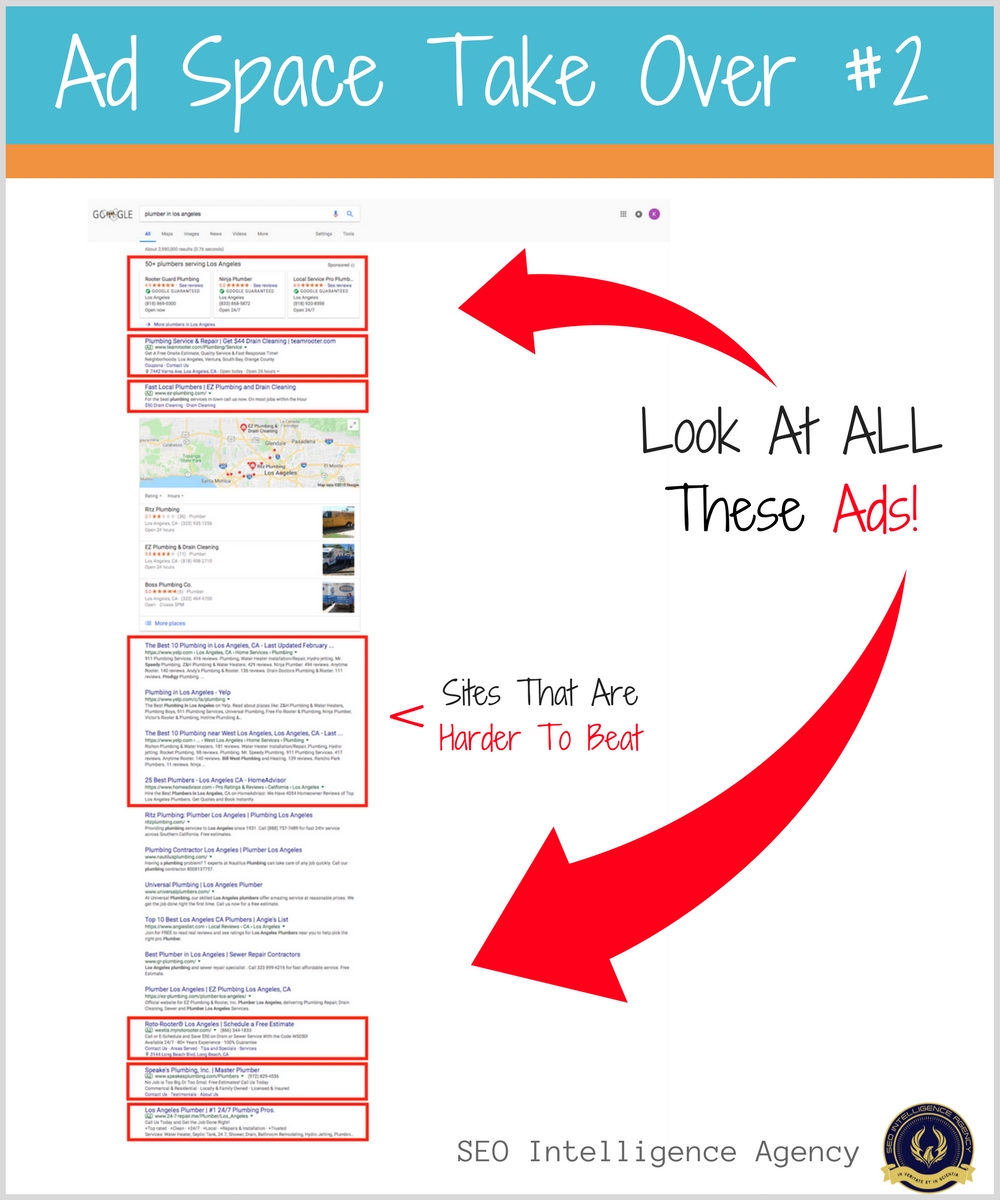 .
.
PPC and SEO Must Be Used Together – And Here’s Why
Most marketers look and PPC and SEO as two different strategies:
- Organic traffic
- Paid traffic
But there is something that overlaps that will increase your ROI.
One of the most important aspects of both is finding the best keywords. Using both PPC and SEO together will yield you better results.
Check out how to use these together to increase your ranking efforts.
PPC and SEO Working Together
If you look at the Google search results, you will often see ads first, a Google map section and then ads down at the bottom of the page.
Notice in the above picture that there is an ad in the Map Pack. Google is now giving more ad space on pages.
In this picture, there are a total of 8 ad opportunities!
Even if you are struggling to rank your site on page 1 of Google, you still have a chance of being seen on page 1 with PPC.
SEO And PPC Strategy
Have you heard the saying, Never put all your eggs in one basket?
How about diversify, diversify, diversify?
Combining both the AdWords program and SEO allows you to get the best of both worlds.
Make Sure Google Sees You
When you pick the right keywords, Google takes notice. PPC can help you find the keywords that will make sure Google not only sees you – but LOVES you. You will be rewarded with better exposure in search engine results pages (SERPs).
Don’t Reduce Ad Spend
Don’t let your clients drop their ad spend once their keywords rank high. Depending on the niche, PPC ads make up the first to the fourth positions on Google’s first page. By dominating the organic search AND paid search, you are really increasing your traffic.
Finding Keyword Gold
Your PPC campaigns holds amazing value for mining your keyword gold. By looking at your data, you can decide which keywords will hold the highest potential, and use the gold that you found to improve your SEO strategy.
Test Organic Keywords with PPC
You can refine your keywords further with PPC ads. You’ll be able to test how the keywords you want to rank for will do. This will allow you to make adjustments to your strategy.
PPC Ads And Organic Webpage Content
There is a special formula that can give you the greatest gains for your money. What scores big in PPC tells you what will do well in SEO.
By cloning your PPC ads, you will be able to see what the best content to go after will be.
You will know that this is content that converts. Also having the words on your page match the words in your ad lowers your cost per click rate.
From your PPC ads, you will be able to create your meta information: title tags, descriptions and even page content on your website.
If you follow this method, you should see immediate results, instead of waiting for Google to crawl your page. This will tell you what works organically and what does not.
Enable Site Search Data For More SEO
PPC advertising has a benefit when it comes to finding the keywords your customers are typing in to the search engine.
When you enable site search on your website, you can analyze the terms most often used by your customers. PPC and site search data help give you customer habits and search needs. This allows you to serve up exactly what your customer’s need.
Use PPC & SEO To Combat Negative PR
It happens. Someone will have something bad to say about your company. And usually small company owners will freak out.
There are remedies to overcome negative PR.
Using PPC and SEO together can rocket boost your damage control. If you control the SEO and PPC results for a certain term, you can control how people think and feel about something.
Do you remember the Gulf Oil disaster where the oiled spilled into the gulf?
BP relied on PPC ads to control what people saw and thought about the spill. BP’s image took a hit. So they turned to paid ads.
Instead of hiding they became proactive and controlled the oil spill keyword. They linked an article on their site about what they were doing to clean up the spill.
It was an effort that paid off. When someone typed in oil spill, the first thing they saw was the BP ad.
You can use PPC to tell your side of the story and reduce damage.
Are Adwords and PPC the Same?
Pay per click, or PPC for short, is where you run ads for paid traffic through programs like Google’s Adwords program.
Google Adwords is the platform in which paid ads can be run.
In Google Adwords, Google allows your ads to be shown in the search engine pages. The fees for this are based on competitiveness of your keyword and how well your ad matches what is on the page that you are sending the clicks to. When someone clicks on your ad over to your site, you are charged that set fee .
.
Sum It Up
Without adding any more time to your research, you can use the greatest keyword tool to find money keywords for your content. This helps to create better conversions.
And who doesn’t want that?
]]>
 In true Dori Friend style… you won’t read about Rand Fishkin or Brian Dean here. No matter how much of a big deal Neil Patel is you won’t find him on this list either.
In true Dori Friend style… you won’t read about Rand Fishkin or Brian Dean here. No matter how much of a big deal Neil Patel is you won’t find him on this list either.
This isn’t the typical list you see on most of the “corporate” sites who publish top SEO lists of SEO’s that have “jobs” in the corporate setting. This is the cr rolex daytona mens rolex calibre 7750 116518 automatic list of the “real” SEOs who most of the corporate SEO’s get their information from!
This is the list of top SEOs that are underground, doing SEO for themselves or their own agency and use SCIENCE to predict what works and doesn’t on Google. There are many so many in our circle that are absolutely incredible, but we narrowed it down to 10 of whom we thought were the top SEO Influencers in 2017 and will continue to be in 2018.
These influencers are part of our S.I.A. SEO network that has been quietly underground making Google their b@#%h. And today… I am going to expose & honor these SEO Influencers with the S.I.A. “BEST Influencer Award.”
I also chose to share with you “just one” of many great tips these top influencers have shared with us in the past year in the S.I.A. Enjoy! – Dori 
Top SEO Influencers Think Differently
Our List of TOP Search Engine Optimization Experts
(The Real Google Code Crackers!)
SEO Influencer #1
 Clint Butler – You always have to be on the lookout around Clint because his SEO mind explosion nugget can’t be anticipated.
Clint Butler – You always have to be on the lookout around Clint because his SEO mind explosion nugget can’t be anticipated.
Often understated and underestimated, Clint’s tactics are lethal and deadly to the competition.
As a retired Non-Commissioned Officer in the United States Army and a 21 year veteran of the military police corps, Clint is coil vape tactical with his SEO.
He has educated hundreds of entrepreneurs, freelancers, agency owners, and business professionals on how to get REAL results from SEO, social media marketing, and video marketing.
Over the past 7 years, he has held educational webinars on the topic of SEO, founded a digital marketing agency and created online courses for Facebook marketing.
Visit Clint at: https://www.digitaleer.com/
Clint’s 2018 Nugget of Wisdom for you:
“In 2018 On Page SEO is going to be the foundation for which all SEO will be built on.
Those willing to go beyond the basics and learn both technical and visual aspects of on page SEO will find themselves competing better in the SERPS and having to build way less links.
On Page SEO, to do it right, is boring and takes a long time. Clients will hate it when they have to wait for you to do it right, but they will love you when they get the benefits from the results.”
Follow Clint: https://www.facebook.com/clint.a.butler
SEO Influencer #2
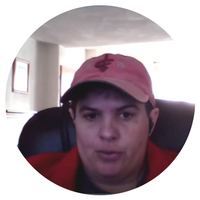 Holly Starks Cooper – Holly has had a rebirth. If you have not met her or seen her speak, WOW! Because you are missing out.
Holly Starks Cooper – Holly has had a rebirth. If you have not met her or seen her speak, WOW! Because you are missing out.
Her rebirth made our jaws drop. Coming from being so black hat she made people feel dirty when she talked about her ranking tactics, Holly has decided to play more by Google’s rules and exploit them from the inside.
And she does it so freakin’ well.
You also probably don’t want to be in a niche she decides to go after…
Because she is THAT good.
Her dominion is Video Marketing.
She has live streamed over 3.5 million video’s per year, had close to 150,000 Youtube Accounts, and has been dubbed ‘The Youtube Queen’ in some circles.
Holly is renowned as both an online and offline marketer and hosts several live events through out the year helping other marketers reach their full potential in Video Marketing.
She is an industry favorite and has garnered the attention and respect of the top video marketers online. She is also quickly becoming a sought after speaker.
Holly has also created 5 tools and has released 4 courses that have helped propel her to internet stardom.
Holly’s 2018 Nugget of Wisdom for you:
“For 2018 blow out prediction … I predict YouTube to overtake the #1 search engine, #2 to be google and Amazon to be a close 3rd. Amazon is opening their own video section to compete with youtube next year so I suspect they will continue to pick each other apart.
That and BTC will hit 50k by the end of 2018. Lol”
Follow Holly: https://www.facebook.com/greeny1232
SEO Influencer #3
 Derek Booth – When Derek isn’t uncovering a gold mine of converting keywords that very few people know about, he is busy creating a Google AdWords blueprint and step-by-step courses to help reduce waste in advertising accounts.
Derek Booth – When Derek isn’t uncovering a gold mine of converting keywords that very few people know about, he is busy creating a Google AdWords blueprint and step-by-step courses to help reduce waste in advertising accounts.
Derek found a unique way to merge PPC and SEO that can help give any page in any niche an edge. He is in the process of developing his own software ‘The Marketing Brain’.
If you’ve struggled at adwords ads or want to up your SEO game in 2018, Derek’s PPC can help give you the edge.
Visit Derek at: https://www.sigmaweb.co.uk
Derek’s 2018 Nugget of Wisdom for you:
“When 1st setting up CPC prices I use two options depending how much time I will be spending on the project. If this is a big spend and I will be putting a lot of time into it I always start with around 50% of the first page bid price. If this is not such a heavy account I would start with 75% of the price.
In the first few days I keep going in to the account and slightly increasing the bid price.
This will result in lower click cost for the duration of the key word providing you don’t jump the bid price.
Always gradually increase the price and in the first 10 – 14 days be patient.”
Follow Derek: https://www.linkedin.com/in/derekboothsemseo/
SEO Influencer #4
 Stephen Grealy – Don’t let his Elvis impersonations fool you, this funny guy gets serious results with CRO (Conversion Rate Optimization), FB Ads, and SEO.
Stephen Grealy – Don’t let his Elvis impersonations fool you, this funny guy gets serious results with CRO (Conversion Rate Optimization), FB Ads, and SEO.
When you can’t get something to move in the SERPS, he is a definite go to for help.
Stephen really gets the conversation going when he drops SEO nuggets in the SIA Skype chat. He shocked everyone with his depth of information and willingness to give at the SEORockstars event.
Stephen has been doing SEO professionally for 15 years. He specializes in the Finance sector and ecommerce. His information can span any niche.
He is a favorite for CRO, landing pages and automated sales activation – a great all rounder.
Stephen has a couple of must have courses that will be launching in 2018.
Stephen has been such a best kept secret that he doesn’t even have public profiles to follow him… yet. However, if you are on the SIA email list, you will hear more from him.
Stephen’s 2018 Nugget of Wisdom for you:
“Google’s gotten lazy but beware the sleeping crocodile! The future for GMB is top contributors. I can see that google will ignore reviews unless they are trusted in the future so you should find out who your top contributors are locally and invite them to review your site – the alog will change over time and you will be so far ahead of everyone else.
You will not need to geo tag your images or keyword the GMB. I am a level 5. Google gives me a list of everywhere I have been for the week and asks me to review so unless you are using a mobile phone that records the real location these review will more than likely be removed.”
SEO Influencer #5
 Jeff Lenney – A newcomer to the SIA this year, Jeff jumped in with both feet and started sharing his years of experience right away. We also found that a little Jonny Walker will loosen him up and get him to spill even more of his secrets.
Jeff Lenney – A newcomer to the SIA this year, Jeff jumped in with both feet and started sharing his years of experience right away. We also found that a little Jonny Walker will loosen him up and get him to spill even more of his secrets.
He’s like an energizer bunny of SEO. His affiliate and launch jacking business has earned him the title of King of Launch Jacking.
He earns rave endorsements from Anik Singal, Jimmy Kim, and Aiden Booth.
Jeff has become the lethal weapon with SEO and Launch Jacking that you want to know.
He made a 6 + figure income in one weekend, without buying ads! That’s how powerful his SEO is. He’s protective of his information but will regularly release some mind bombs that earn him the title of a top SIA SEO.
His 2017 course was in high demand, so we expect his 2018 courses to sell out fast.
Visit Jeff at: https://jefflenney.com
Jeff’s 2018 Nugget of Wisdom for you:
“Once you master ranking, focus on quality content that CONVERTS. I sometimes spend hours tweaking one review or blog post to make it not only read well but LOOK amazing as well.
Use Headings, Bullet Points, Numbered Lists, and Bold Text you want to draw attention to.
Use CTA text on your buttons instead of just Click Here or Buy Now text.
While this may seem like it is Not mind blowing, I’m still surprised how many people DON’T put time into conversion optimization stuff within their content itself.
There’s a lot you can do to increase your earnings (or your customers earnings) with the same amount of traffic you already have.”
Remember, Jeff can make in a day what a college degreed engineer can make in a year. His advice is worth paying attention to.
Make sure your content stands out!
Follow Jeff: www.facebook.com/jefflenney
SEO Influencer #6
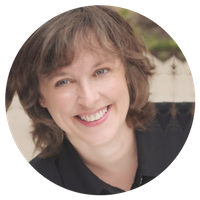 Carolyn Holzman – Carolyn is a serious powerhouse in the SEO world. She’s a self-proclaimed super nerd, but we think she is a super genius.
Carolyn Holzman – Carolyn is a serious powerhouse in the SEO world. She’s a self-proclaimed super nerd, but we think she is a super genius.
Don’t think she is unrelatable because of her super genius status… she has the ability to break down complex SEO solutions.
Even someone newer to SEO can understand what she teaches.
In her previous life, she was a professional violist so her brain is naturally wired to look at SEO in a very unique way. She can read between the lines and see what other marketers can’t.
In 2016, her presentation dropped our jaws at the SEORockstars conference.
Not only does Carolyn have years of experience and certifications, she has been trained by some of the world’s most renowned experts.
She is definitely someone you should be following. Get out your gel pens and write down her 2018 tip.
Visit Carolyn at: americanwaymedia.com
Carolyn’s 2018 Nugget of Wisdom for you:
“This one is fresh out of the oven – found it around Christmas time.
Words that are hyperlinked to content sections within the same webpage have their own permalink. e.g. http://www.domainhere.com/#anchor-text
This link can be used to build links back to the page – which I believe ultimately will build relevance to whatever the topic is on that section.
I’m currently setting up a test to see if a link using this url is a ranking factor – will get back on this once results start to come in.”
Follow Carolyn at: http://twitter.com/carolynholzman
SEO Influencer #7
 Ryan Hough – As one of the SIA official testers, Ryan has a lot of knowledge of what works in the SEO world and what doesn’t. He loves sharing his knowledge and experiences fully.
Ryan Hough – As one of the SIA official testers, Ryan has a lot of knowledge of what works in the SEO world and what doesn’t. He loves sharing his knowledge and experiences fully.
As with an ISTP personaliy, Ryan loves learning from the SEO world as he goes. He’s not afraid to roll up his sleeves and dig in to find out what really makes something tick. He loves troubleshooting and trial and error.
This means he sets his sites high.
In his own marketing company, he focuses on helping small to medium sized businesses increase sales by 50-300%.
One of the great things about Ryan is his dedication to always over delivering.
Visit Ryan at: http://www.perthmarketingcompany.com.au/
Ryan’s 2018 Nugget of Wisdom for you:
“My SEO tip for 2018 is to create more content that answers questions. I’m seeing good results from this now so I expect this trend to continue in 2018.
For example, “What is keyword” or “How much does keyword cost?”. This content is great for adding to web 2.0 properties and interlinking these articles together.
You can find plenty of content ideas on Quora (or any Q&A site that serves your industry). This type of content is easy for writers to rewrite and can be produced at low cost. Usually the keywords are long tail/ low competition and so good on-page, interlinking and a small amount of traffic can quickly result in top 10 rankings.
This content can start a snowball effect of traffic to your website and I believe traffic will be the most important SEO ranking factor in 2018.”
SEO Influencer #8
 Simon White – Here is a SEOer that you want to fanboy (or fangirl) over. Even though he sounds like a member from the Beatles, his claim to fame is rockin’ SEO results.
Simon White – Here is a SEOer that you want to fanboy (or fangirl) over. Even though he sounds like a member from the Beatles, his claim to fame is rockin’ SEO results.
When he is not searching to find English style fish and chips, he is helping to rank some powerful companies.
Simon is involved in numerous SEO groups to help spread the truth about SEO and continue to stay ahead of the Google game.
Visit Simon at: https://localblitz.com/
Simon’s 2018 Nugget of Wisdom for you:
“Don’t follow SEO Guru’s advice blindly!
Use science and engineering methods to test and tweak your SEO efforts. Single variable testing methods are extremely helpful in determining the true ranking influence of a particular SEO factor.
Another great approach for 2018 is to analyze your site against your competitor’s sites to discover opportunities for improvement.
Integrate CRO (Conversion Rate Optimization) into all your SEO efforts in 2018. At the start of every project we install Tru-Conversion (similar to hotjar) for heatmaps, site visitor recordings, funnel conversion tracking and form fill tracking.
Increase your SERP click through rates with Title Tag and Meta Description testing and optimization.
Encourage your clients to use live chat on their sites as it boosts conversions and time on site. We use Drift but there are many others.
There are too many SEO Guru’s who just regurgitate untested SEO theories. Science and engineering is the true way to influence your work in SEO.”
SEO Influencer #9
 Jose Ponce Jr. – Half of a Dynamic Duo, Jose and his business partner, Mitchell From burst onto our radar this year.
Jose Ponce Jr. – Half of a Dynamic Duo, Jose and his business partner, Mitchell From burst onto our radar this year.
Jose adds his skill for problem solving to SEO. He leaves no stone unturned and will work to make sure people have exactly what they need. He doesn’t believe in cookie cutter approaches to SEO.
With his background in IT, he brings a different view of SEO to anyone lucky enough to follow him.
Jose and Mitchell put their heads together to come up with some 2018 predictions.
Visit Jose at: https://authoritysolutions.com/
Jose’s 2018 Nugget of Wisdom for you:
“As we wrap up the fourth quarter of 2017 and reflect on how SEO has evolved this past year it is important to begin strategizing to position ourselves ahead of others in our industry. Below are four areas I feel are the most important to focus on for a successful campaign strategy this coming year.
Authority Building – continue to explore what Google deems to be an authoritative citation and focus on ways of maximizing the transfer of it to our properties.
Visibility Development – with the rise in mobile search trends, Page speed optimization is a crucial skill to learn and develop moving forward. Consider implementing the WP-Rocket in conjunction with CloudFlare for some quick gains in this area.
Engagement Intensity – as we’ve witnessed a huge shift in SERP layout changes with Ads, and other featured snippets like Answer boxes, and carousels this last year; mastering CTR is going to be something extremely important to stay on top of in order to capture your targeted audience’s attention and heighten that “Look at me!” factor.
Conversion Sovereignty – As we at Authority Solutions have personally experienced the evolution (over the last few years) of going from being an “SEO” to stretching ourselves and morphing into a full-fledged Internet Marketing Agency we have come to understand the importance and role of reporting on conversions over rankings alone. At the end of the day what really matters to the client is ROI.
have personally experienced the evolution (over the last few years) of going from being an “SEO” to stretching ourselves and morphing into a full-fledged Internet Marketing Agency we have come to understand the importance and role of reporting on conversions over rankings alone. At the end of the day what really matters to the client is ROI.
So to wrap things up I leave you with this, 2018 is set to be an exciting year for Internet Marketing. Aside from what I have mentioned above, one of the most crucial things I can relay to those of you looking to take your skills to the next level is to silence the noise, and stop chasing shiny objects. Implement what you know has been thoroughly tested and undoubtedly proven to get results!”
Follow Jose: https://www.facebook.com/authoritysolutions/
SEO Influencer #10
 Josh Bachynski – Do you know anyone that has done a Ted Talk? We do… and here he is. His Ted Talk was titled, The Future of Google Search and Ethics.
Josh Bachynski – Do you know anyone that has done a Ted Talk? We do… and here he is. His Ted Talk was titled, The Future of Google Search and Ethics.
The title probably gives you a pretty good idea of why he is on our SEO Influencer list.
With 3 black belts in martial arts, he’s a definite SEO Warrior. He focuses his energy on listening and interacting with every Google talking head that rises to the position.
He knows the tricks. He can see through the lies. And he is REALLY good a deciphering Google SEO speak.
Consider him the best Google decoder you could ever hope to meet. He also has a YouTube show called White Hat–vs- Black Hat every Wednesday.
Visit Josh’s Youtube Channel: https://www.youtube.com/channel/UC_VoVYVFhtWDhYYXSiYQbNA
Josh’s 2018 Nugget of Wisdom for you:
“I predict in 2018 AI will become a major factor in SEO in a pronounced way!
Google is at the head of AI in the world – they recently made AIs to beat any poker player, the top Go players, and any chess players, and an AI that makes its own (better) AIs.
John Giannandrea (their former head of AI) has been the head of search for a couple years now.
They have invested heavily in AI already: Rankbrain being chief amongst them, at least 30% of the algorithm, they call themselves an “AI first” company.
It has long been Larry Page’s policy not to hire humans to do what a computer can do.
BUT they just hired thousands of humans to deal with the “fake news” crisis.
It is a given they will make or continue to use some AI in 2018.
And I think, given what they have done already with poker and Go, they are positioned to make a killer AI app this year, maybe a smart(er) assistant, maybe AI based rankings in general in some areas, and or maybe an AI to police highly politicized searches to make sure their answers are always more politically correct.
This also Includes “fraud detection” (he was talking about financial fraud) but they could easily apply that to search fraud aka black hat seo, easily.
Also “video understanding” so ranking videos on youtube or google based on what us said / done in the video… and “reading and understanding a document” like a human does…”
Josh can go on with what this means for SEO in 2018, but if you follow him you’ll get the latest breaking Google news.
Follow Josh: https://twitter.com/joshbachynski
These Top SEOs haven’t just been able to rank in the past; their finger is on the pulse of what is coming.
2018 SEO Trends
This is just a sample of the SEO trends that will dominate search engine rankings in the future:
- Mobile first rankings
- Voice Search
- Schema will continue to gain importance
- Featured snippets
- Relationship building through content
- Speed
- Technical SEO
- Unconventional linking – our SIAer’s make linking fun
- How to use AI to your advantage
There was a time when people had an attention span of 7 seconds. Then you had to grab their attention in the first 3 seconds.
Now?
There is really NO attention span in the online space.
This means you have to learn how to stand out.
You have to grab someone’s attention instantaneously.
It’s not enough to just have a few SEO tricks up your sleeve anymore… You have to stand out.
This is one thing that our influencers have incorporated into their SEO knowledge.
But… I’m not done pulling back the curtain just yet…
SEO Ranking Software
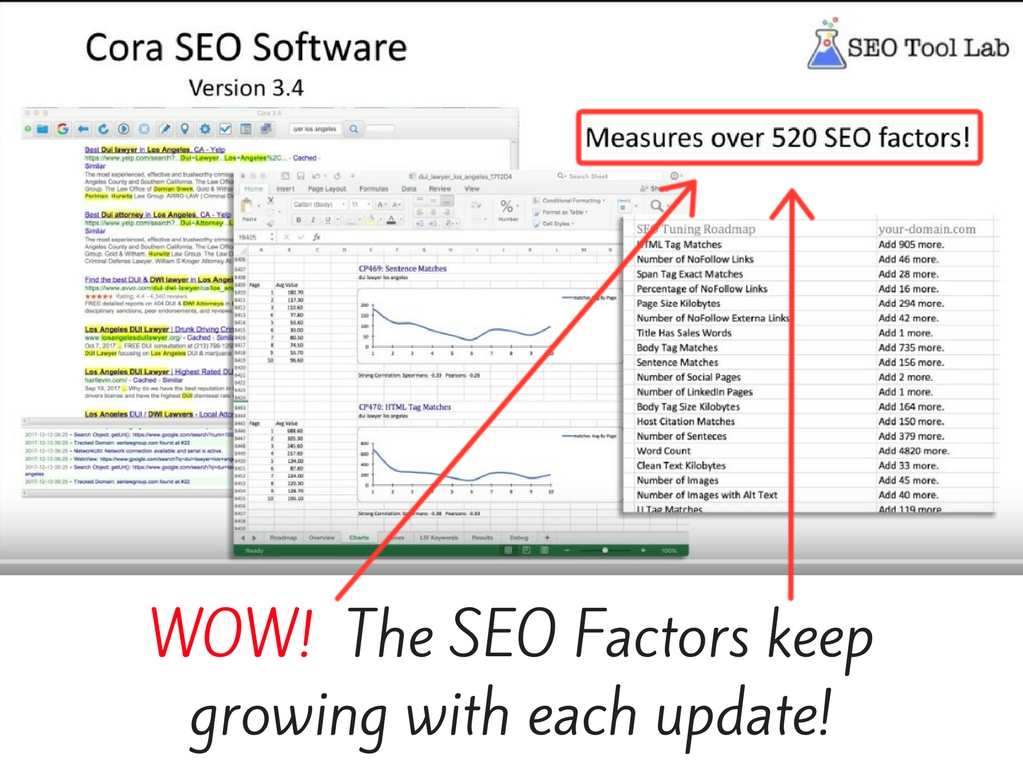
The SEO influencer list would not be complete without mentioning the most groundbreaking and powerful software that has given our influencers super powers…
This software is named Cora.
It was created and continues to be evolved by Ted Kubaitis.
This is THE software to have in your SEO arsenal in 2018. It makes knowing exactly what Google wants in your particular niche as easy as reading a report.
If you’ve got your on-page SEO strong, this tool will be the one your competitors do NOT want you to use.
It can be as powerful as a nuking your competitors… if used correctly.
If you can follow a map, you can follow the SEO suggestions that Cora gives you.
Cora measures over 400 SEO factors in your individual niche. This helps remove any of the guesswork of what you need to do.
Or what you should avoid.
Your time is important, right? If you are doing business online, time IS money. Wasted time means you are throwing money right out the window.
Cora will tell you exactly what to do. And what is most important for you to go after.
Chances are you are in business to make money not lose it.
Cora is one of the FEW pieces of software that truly lives up to its hype.
Don’t waste another day in 2018 spinning your wheels trying to rank your sites…
Last but not least…
Here is a ninja 2018 SEO tip from yours truly (Dori)…
LOCAL SEO Expert Ninja Tip… I bet you don’t know.
Now we all know that mobile is/has come on strong and currently comprises 75% of all Internet use, and According to Google, a third of those mobile searches are LOCAL!
And, Google also let out that that local searches on mobile devices are growing 50% faster than mobile searches as a whole. But you probably knew that.
But I bet you didn’t know what else has grown recently and is the genesis of this “Local Ninja Tip,” and that is the number of searches with the words “near me” in them.
These local modifiers have increased in spades and “near me” has doubled in just the last year. Here is good old Google Trends data to prove it. 
So here is the ninja tip.
Ready? 
Add ‘near me’ copy on your pages.
I can just hear you saying, “yo Dori, seriously?” And I say back.. “Yep, you heard me right, those two words will increase your click-through rate by 81%!” ::mind blown::
Don’t believe me? lol There was actually a study that covers this over at CDK Global.
They studied 82 auto dealers over a five-month period and found that those that added ‘near me’ content got that striking increase in click through rate, AND it also increased impressions by 15%. HA!
That is a pretty easy hack if I do say so myself, but you are wondering how to incorporate that, here is an example below.
So needless to say LOCAL SEO is on the rise.. STILL.
Go follow these influencers, grab the Cora software, use the tool and put the information to use. In a couple of months, send us an email letting us know how much your business has improved in 2018.
Make sure to look for this badge to know if you are following an SIA Influencer!

SocialAdr Social Sharing and Bookmarking have been around for a long time, but everyone that we have seen report on it has just guessed if social sharing/bookmarking works or not. It depends on whom you listen to in the SEO Industry. Whomever it is, they seem to back it up with logical data that makes us believe their theory is correct, but the bottom line, it is always JUST THEORY.
The SEO Intelligence Agency is comprised of a small group of SEO Professionals dedicated to testing & reporting SEO metrics by creating singular tests that allow them to identify ranking variables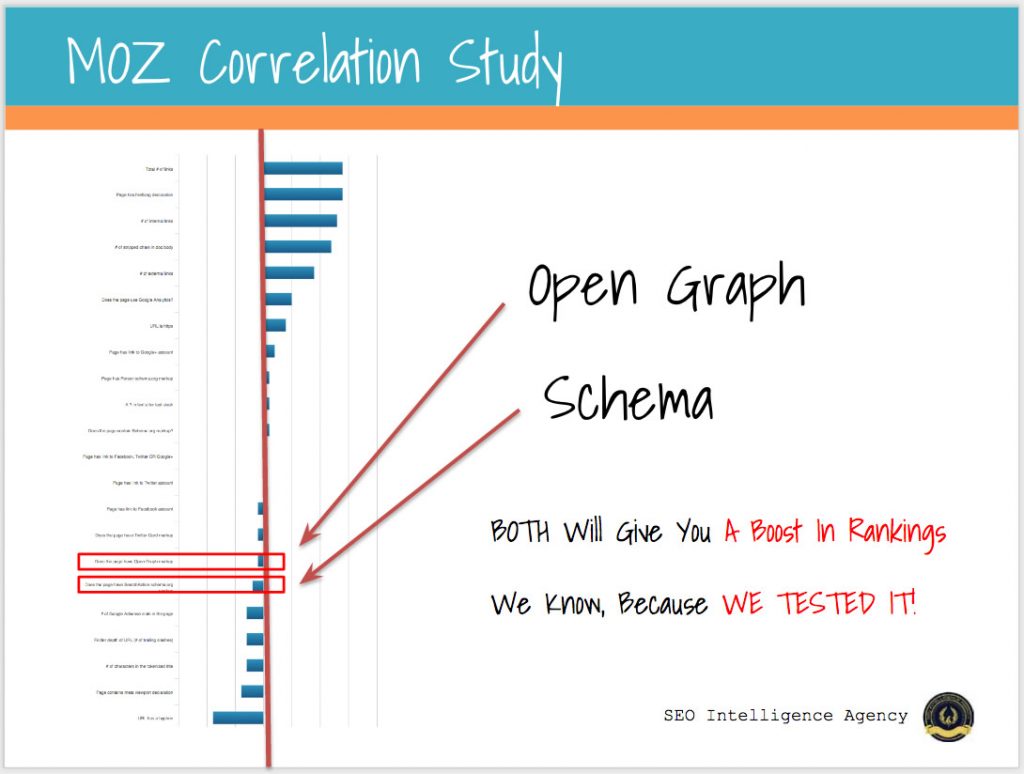 .
.
On this occasion, a member wanted to know if SocialAdr did indeed help rank web properties. We proceeded to create multiple tests in an isolated environment and reported the findings below in a public webinar and transcript is below. Enjoy. 
SocialAdr Social Sharing and Bookmarking Tool Receives Huge Thumbs Up.
04.00: Sir Issac Newton Story Leading Up to Why Testing Is Important
08.20: The Different Between A SEO Enthusiast and A SEO Pro – Testing
10.00: Why Correlation and Case Studies Are Not Effective
16.30: You End Up Getting Dead Wrong Information
18.00: How Myths Get Started
20.18: We Tested 5 of The Things MOZ Said No Longer Work, And ALL Had Positive Results, (meaning they do still work!)
33.25: SocialAdr Test #1
37.12: SocialAdr Test #2
40.05: SocialAdr Test #3
42.56: SocialAdr Conclusion (Best Practices)
45.46: Question & Answers (some really good questions and answers, don’t skip)
55.40: Information on the S.I.A (Click Here)
End: Source Material
Ben Roy (of SocialAdr): Dori Friend has been in the SEO space for a long time and is pretty well known. She is one of the founding members of the SEO Intelligence Agency. But Kyle Roof is a little bit under the radar in our industry. A little bit of a secret presence. He is an expert in all things SEO especially when it comes to data driven analysis.
He is not the type of guy that goes by things that people believe. He doesn’t want to take SEO stuff on face. He is big on testing and proving things and knowing answers for sure. Which led to the SEO Intelligence Agency and figuring out what the truth is about what is working, what is not, and what you should be doing, and what you shouldn’t
4:00
Kyle Roof (from the S.I.A.): Before we start off, let me tell you a story about Isaac Newton.

You might know him for his big hits – gravity, laws of motion, calculus – but before he was doing all that, he was hitting the British aristocracy party scene in the 1660s.

This sort of parties were for the genteel folks, a venue for the opposite sexes to mingle and meet and greet. Isaac dominated the parties when he goes to them and monopolize the time with the ladies. He would be science, science, science, it is the most important thing in the world, etc.
The ladies would swoon.
He would go on to say that science can measure anything and quantify anything. That is an important point because if you can quantify something then you can qualify it, which means that you can study it. He goes on and on about how great science is because of that.
 In one particular party, there was this baron who had enough of it. He walks up and goes “Newton, I’m tired of you, I am tired of your science, science can’t do everything that you say it can, science can’t measure everything.” Newton was “Yes, it can”, “No it can’t, “Yes it can’t”, “Prove it”. So they placed a bet.
In one particular party, there was this baron who had enough of it. He walks up and goes “Newton, I’m tired of you, I am tired of your science, science can’t do everything that you say it can, science can’t measure everything.” Newton was “Yes, it can”, “No it can’t, “Yes it can’t”, “Prove it”. So they placed a bet.
We are not exactly sure what the bet is for but clearly, it is not a good thing because people were going up to Isaac and telling him that he can back out of it, it’s a party, etc. He says not to worry and that he got it cause he has the scientific method.
So the terms of this was, the baron will go to his buddies and talk about something that can’t be measured and Newton has 30 days or until the next party to prove that it can be measured. The Baron goes to his buddies and comes back and takes a long drag on his cigarette and says.. 
“Science can’t weigh the weight of smoke” Newton says’ “I’m on it” and leaves the party.
Fast forward to a month and nobody has seen Newton the entire time. We get to the party and he’s not there. The baron was there and was laughing it up and everybody was getting nervous. Nobody has seen Isaac for a while. Towards the end, he still wasn’t there and it wasn’t looking good.
Suddenly there was a sound at the back of the party and in comes Newton pushing a cart with a tart on top of it. People were “Oh my God, did this guy just invent a smoke weighing machine?”. He pushes the cart in the middle of the room and everybody gathers around. With a flourish, he pulls off the tarp and there was a scale.
At this point, the baron was losing it. Newton then reaches into his jacket pocket and pulls out a cigar. Newton puts the cigar on the scale and says “Ok, we can all agree that the cigar weighs 10ounces”.
So he lights the cigar and goes all the way down to the ash, re-measures that ash and says “We can all agree that this ash weighs three ounces. The weight of smoke is 7 ounces.” The Mic dropped and he said “ladies this party bores me let’s go” and takes all of the ladies out of the party with him.
The moral of the story, aside from the fact that Newton can take your ladies, everything is measurable if you think of it the right way.
Even Google Can Be Measured.
And that is an important idea when you are thinking about the algorithm or you are thinking about what is going on, when we are thinking about what we are trying to do is SEO, it is important to understand that this can be measured, we just have to think of it the right way.
8:20
The difference between an SEO enthusiast and an SEO Pro is that the enthusiast will just tell you something they have read in MOZ or some other blog. The Pro is going to tell you something that they just tested.
10:00
Usually what you run across are case studies and/or correlations studies.
Case studies is where you read something where somebody says “ok I am going to do this” and then they go and do it and share their results. It is a good thing but usually it doesn’t qualify as a scientific test and the reason is that there are too many variables going on.
They are testing within the algorithm which has a lot of other factors that come to play, like a lot of other websites, for example. It is difficult to reproduce what they have done because they are in a particular niche and there are a lot of other variables going on.
One that you see more often than not is a correlation study.
Correlation studies are often very good but the problem with these things is that they often do not tell you exactly what is going on, what is working or not. They just tell you a consensus of what is seen or not seen.
As an example, Stone Temple consulting agree with the idea that correlations aren’t maybe showing you the full picture. What is interesting about this is that the code is, the mean of individual correlations approach, is not providing a complete picture.
The thing that is hysterical though is that in the exact same post, they showed the results of another correlation study that they did showing that the links are still effective and you can check that out. They have also pointed it to another outdated correlation study warning you not to buy links that was published in 2012! (which you would know unless you went to the old article)
Part of the problem with correlation studies is that, then readers take it as fact especially when it comes from industry leaders. The problem is when you do SEO for a few years, you start to see that a lot of these are kind of a rehash or mashup of last year’s mediocre advice.
For example when you see a correlation study often they will say that they are positive correlation that we see and many websites have this sort of a factor but then you will see a negative zone. More ranking sites do not have these things and you think that would represent something that is bad to do or you shouldn’t be doing.
12:55
There is this Moz Correlation study. In the left, it shows certain factors and then it gives you a positive and negative correlation, positive to the right, negative to the left.

What is important though is these two – Open graph and schema.
They are saying there is a negative correlation between sites that have open graph and schema that are ranking for particular keywords. The thing is, in SIA, we actually tested open graph and schema and we know that both gives you a boost in ranking.
We know that because we tested it!
The issue with that is that open graph and schema are advanced and are not easy to understand and implement. They are not in a lot of ranking sites but that does not mean they are not a ranking factor.
But as a result, because there might be difficult aspects in implementation, what shows up in MOZ looks like a negative factor rather than this is actually a ranking thing, just that not a lot of people are using it.
14.10
Another thing is keywords in the domain and this comes from Search Metrics.
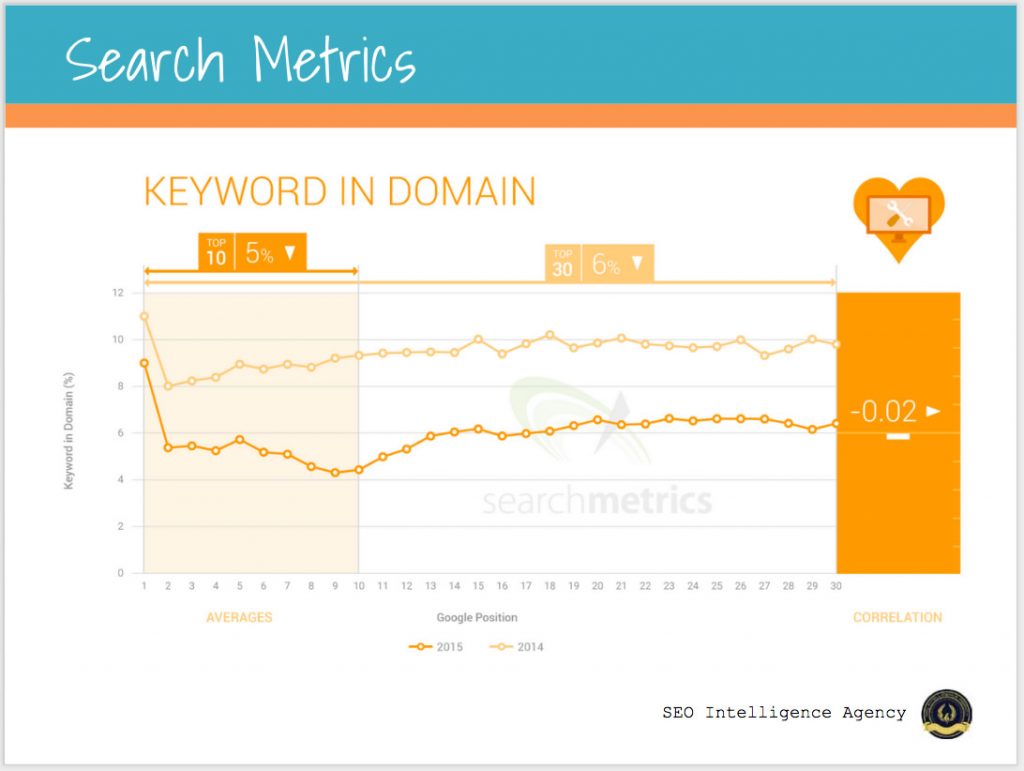
What they are saying is that the sites that are winning in particular target keywords, you see less and less exact or partial match domains. Those are domains that contain the keyword in front of the .com. They are saying that that is going down in the top 10 sites for particular keywords.
The thing is, the real reason that there might be a drop in the usage is that, industry leaders are saying that they do not work anymore.
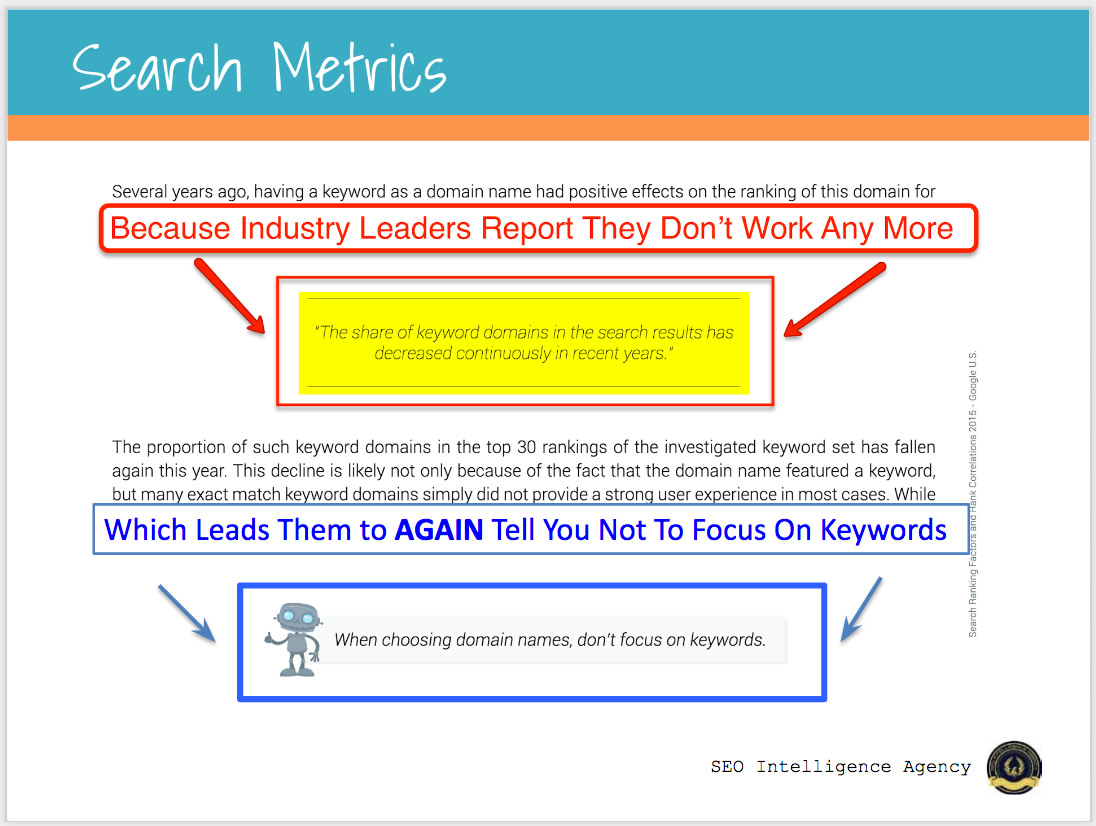
People are not focusing on that and not doing that and they say domains and search results have decreased continuously in recent years and then at the bottom they say it comes from MOZ and they even say their own guide on SEO 101 when choosing domain names, don’t focus on keywords. To back that up, they point to their own correlation study.
What you end up is kind of a cycle of correlation studies.
They give us advice to follow, and then the Google results that when you see something like don’t do exact or partial match keyword domains, people do them less as a result of all the advice, you see them less in results. So that when you do next years correlation study, it will show that there has been a drop in that particular factor.
What perpetuates it even more is that a lot of these studies ask experts that supply the information in the first place, “what do you think?” Then the experts and their opinion says “I think it’s this and I think it’s that” and they often cite correlation studies. You end up with a self fulfilling prophecy of cycles.
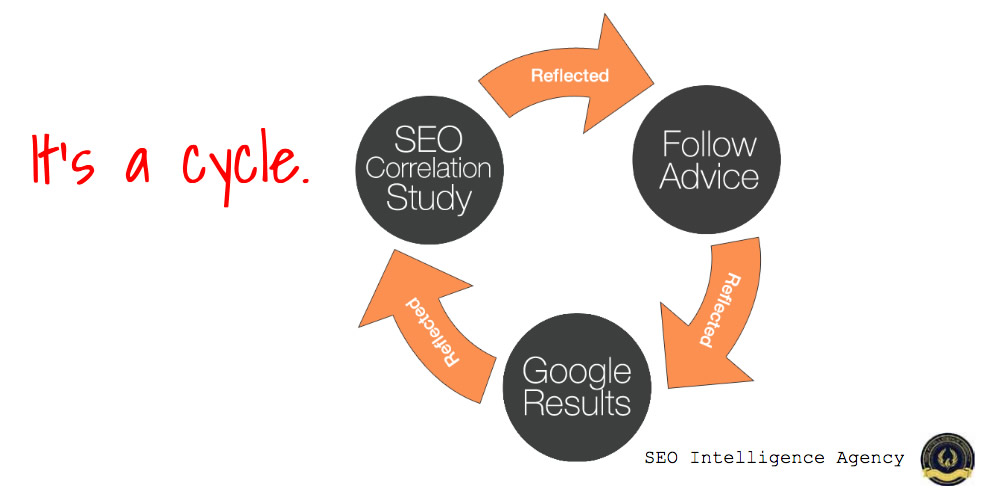
16.30
And, you end up getting wrong information. Information that is unreliable. As a result of moz and search metrics having tons of followers, they perpetuate that cycle, and you have hundreds and thousands of people implementing things that look like potential negative factors, it returns mediocre SEO.
It is the dumbing down of SEO.
But actually that is good for us because the idea is that please follow correlation studies, I’d rather test something and know for sure.
18.00
How myths get going.
This comes from whiteboard Friday and MOZ from April 29. The title is “8 Old School SEO Practices that are No Longer Effective. Number six was exact and partial match domain names do not work anymore. It’s a myth. It used to work but they don’t any longer.
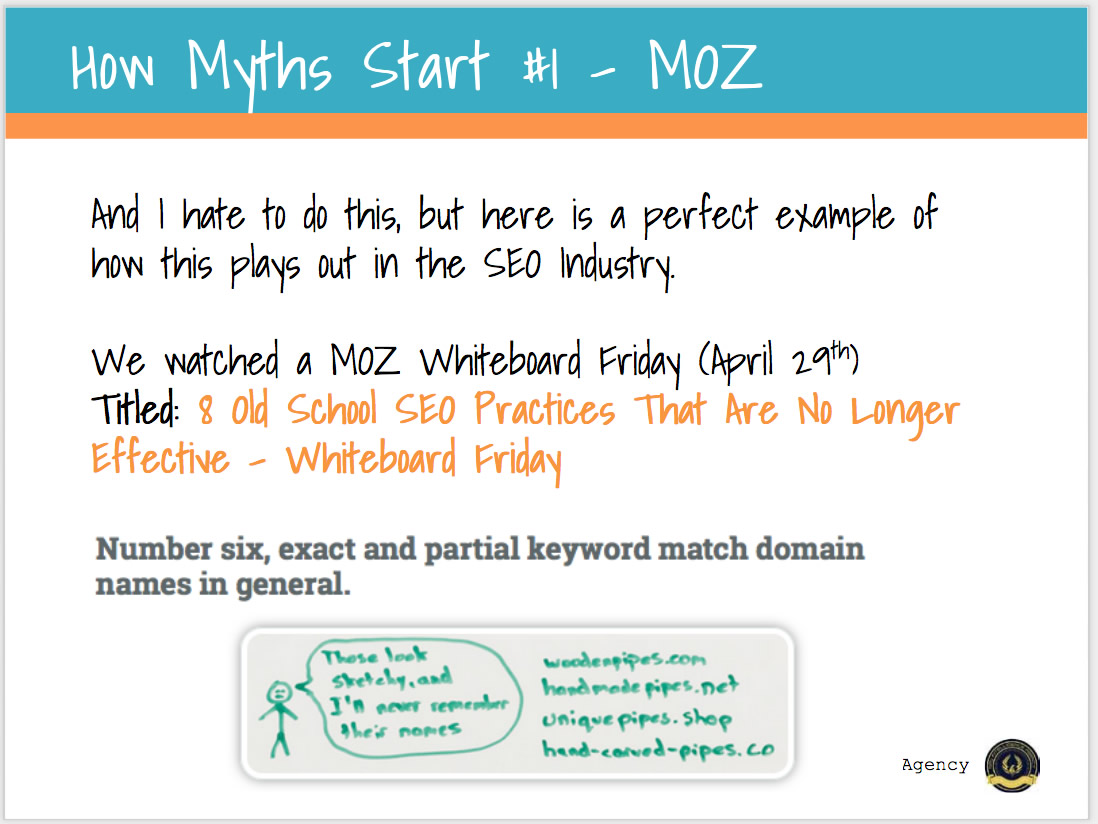
And then again if you look over ahrefs, they too did a “case study” on the term “content upgrades” and they have content upgrades pro where content upgrades was an exact match domain. They point out while it was ranking well, it didn’t beat one particular site and so they come to the conclusion that “Is EMD a strong ranking signal? I don’t think so”.
What is interesting is that they actually double down. In that article, they say “According out our data the use of exact match keyword in the Title, URL, H1, or even within the actual content of the page doesn’t have a significant correlation with Google rankings.”
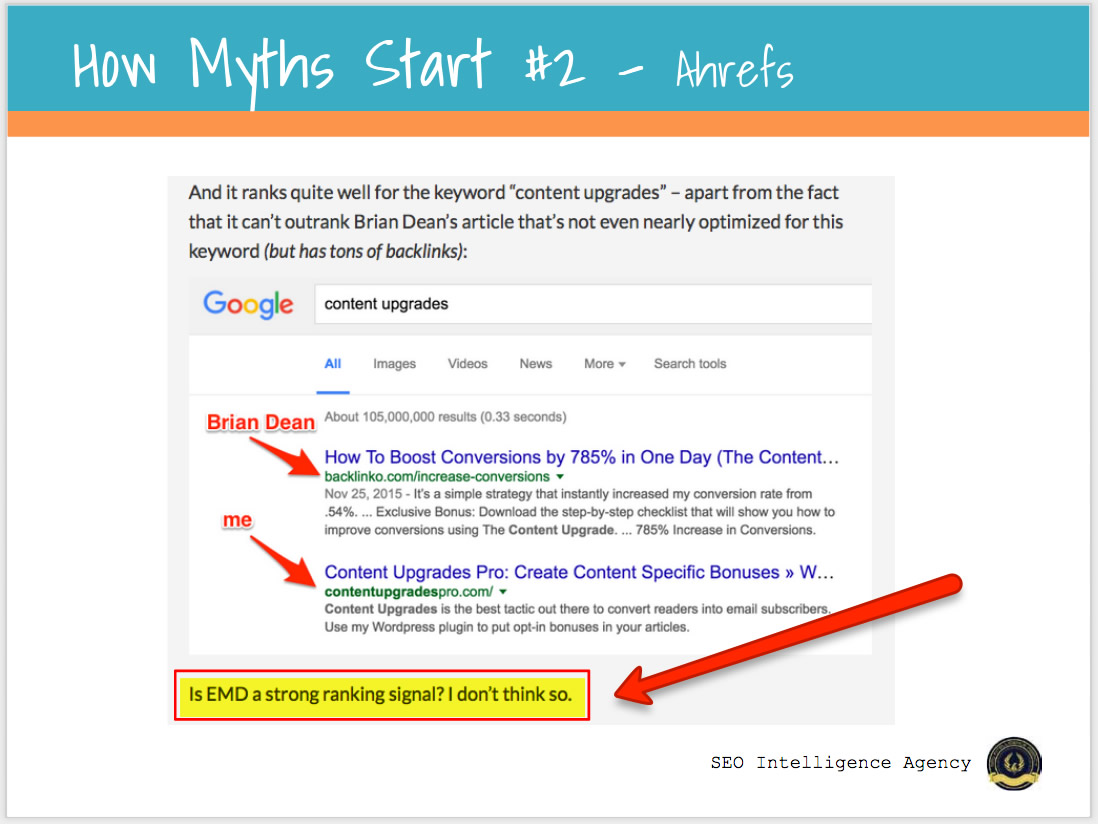
One step back is, why would they be saying this?
Because ahrefs are selling analytics on links so they are making the argument for the power of links and the thing is of course links are strong and of course they are a ranking factor, but to say that those other things are not significant for Google rankings is just flat wrong. Those are things that we know because we tested those things and we know that they are a ranking factor.
20.18
Now, showing you how we test and how it is done, we will go back to the MOZ article about the 8 old school things..
We actually tested 5 of them that “don’t work” and they all were positive ranking factors.
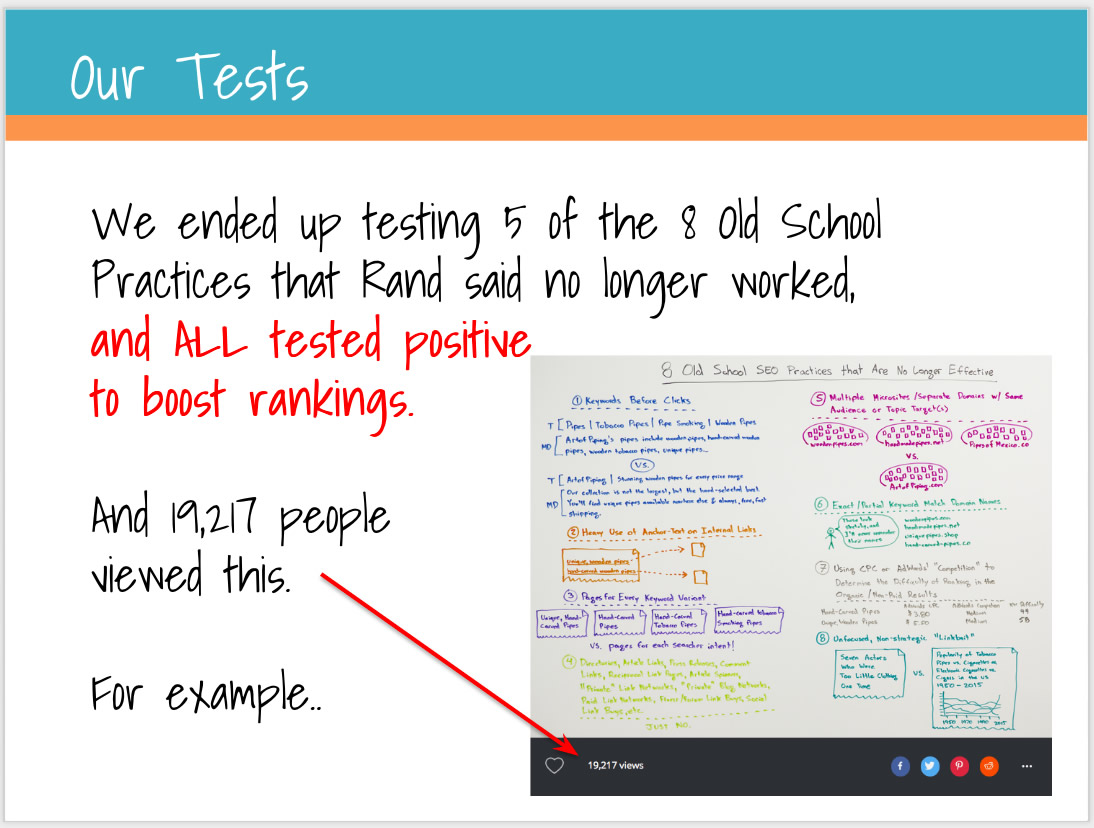
In the keywords in the domain, we had an exact match domain and we pitted it against a partial match, an exact match against a not related kind of domain, an exact match and partial match again a random.
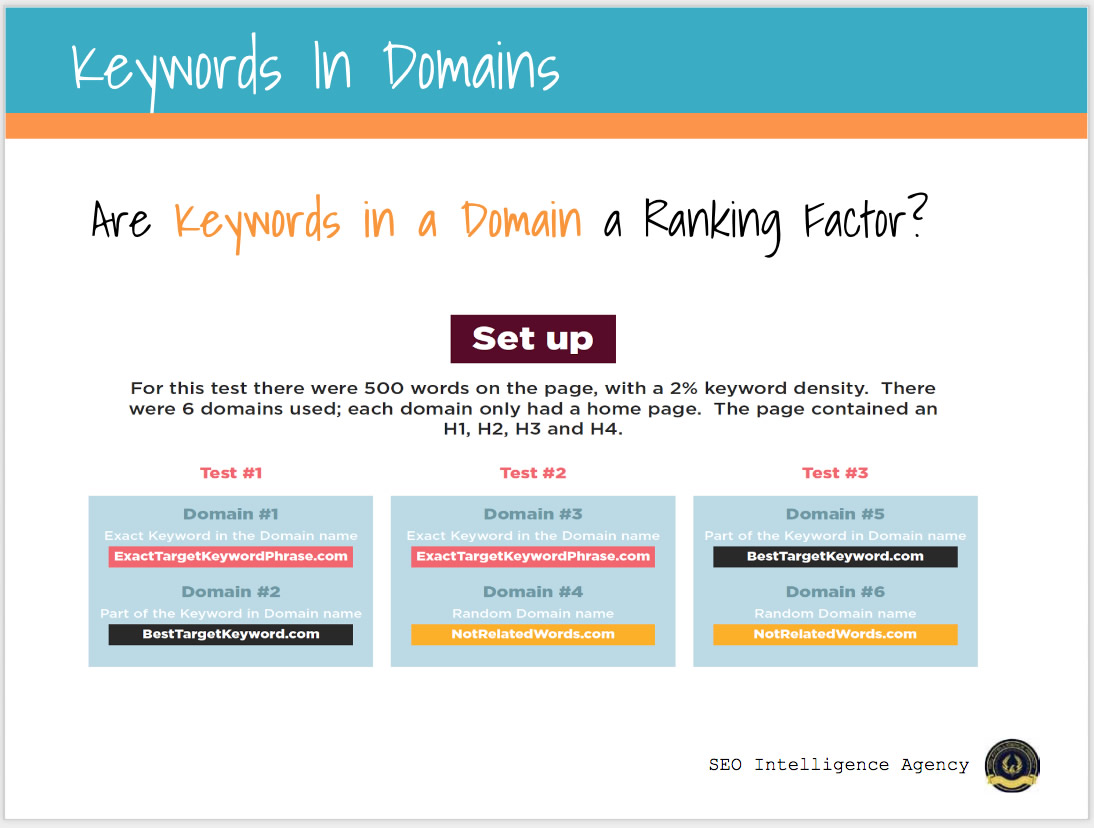
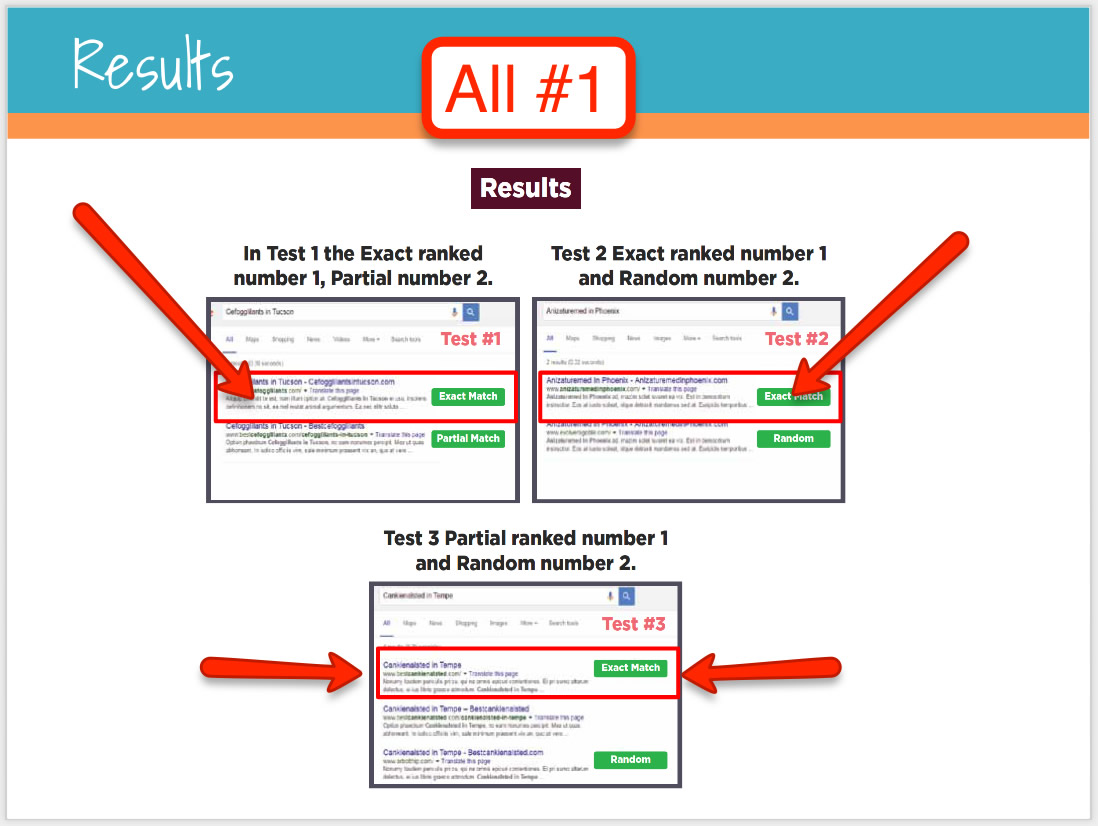
In the results, the exact match beats the partial match, the exact match beats the random, and partial match beats the random as well.
Having the keyword in the URL is a ranking factor.
21.20
This was an interesting one on title optimization. What they were saying here is that a keyword stuffed metatitle will lose to a metatitle that was written for the click as clickbait. Kind of an adwords sort of line rather than just kind of listing out your keywords. We tested this and we know that metatitle is the number one on page factor for your on page SEO. So it is really interesting when someone says don’t put keywords and don’t focus on it because that is the number one place to put it.
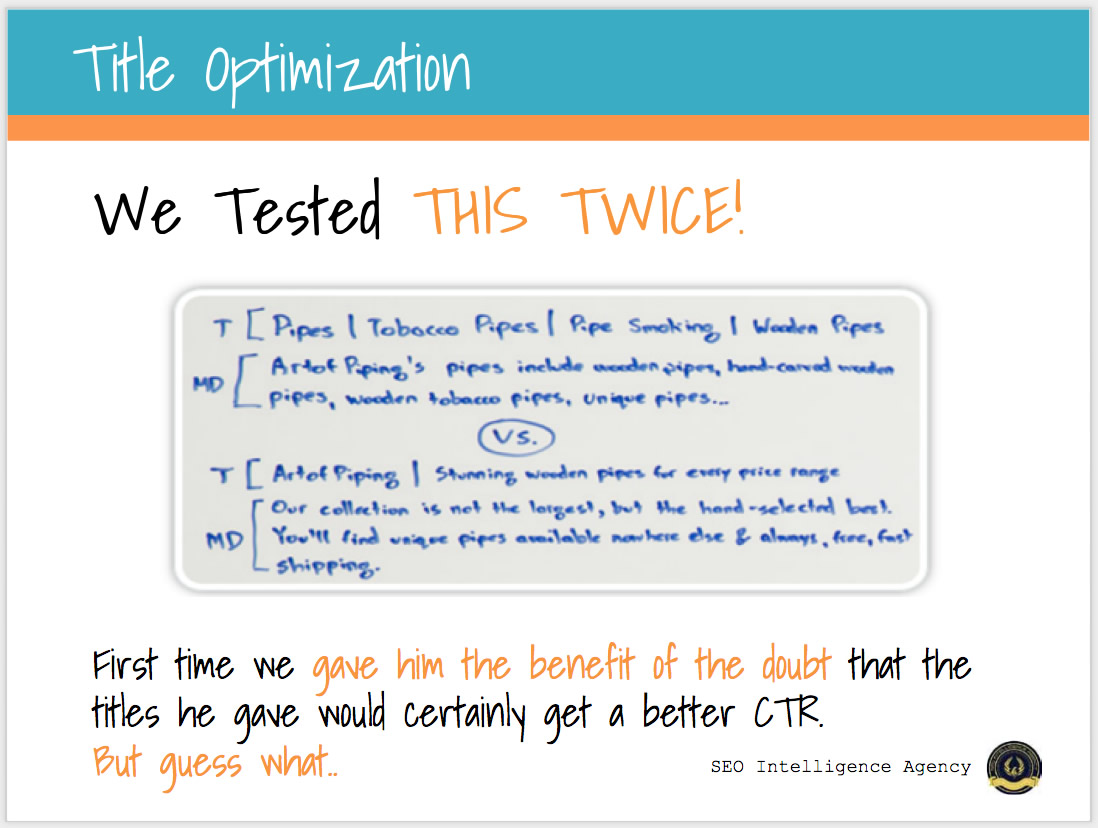
We tested it once and the keyword stuffed outrank a artfully or message written title but then it was ok, the point of the article was that clickthrough rates would be higher so then we tested clickthrough rates and we used a really cool tool called SERP Turkey where you could test organic metatitles and descriptions in an environment with microworkers and what was hilarious was that the keyword stuffed metatitles had a higher clickthrough rate than the ones that were artfully written and we even used the exact ones that were used in the whiteboard Friday. We didn’t doctor them.
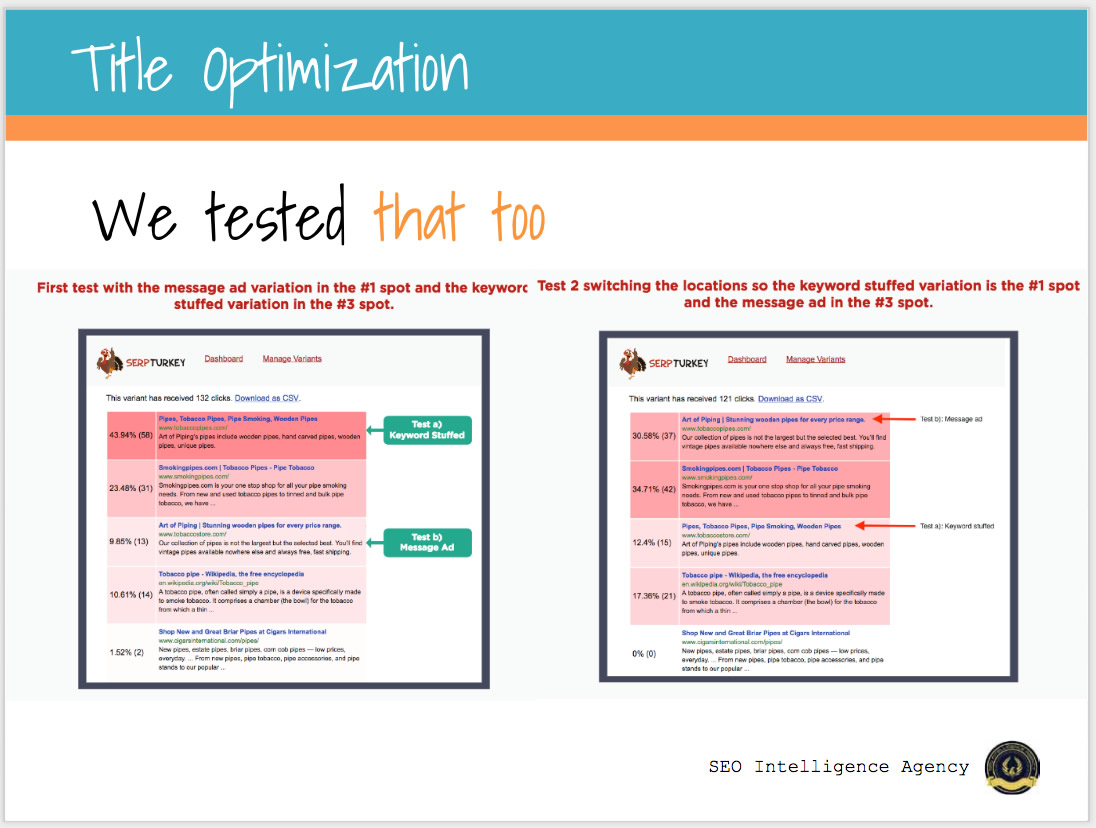
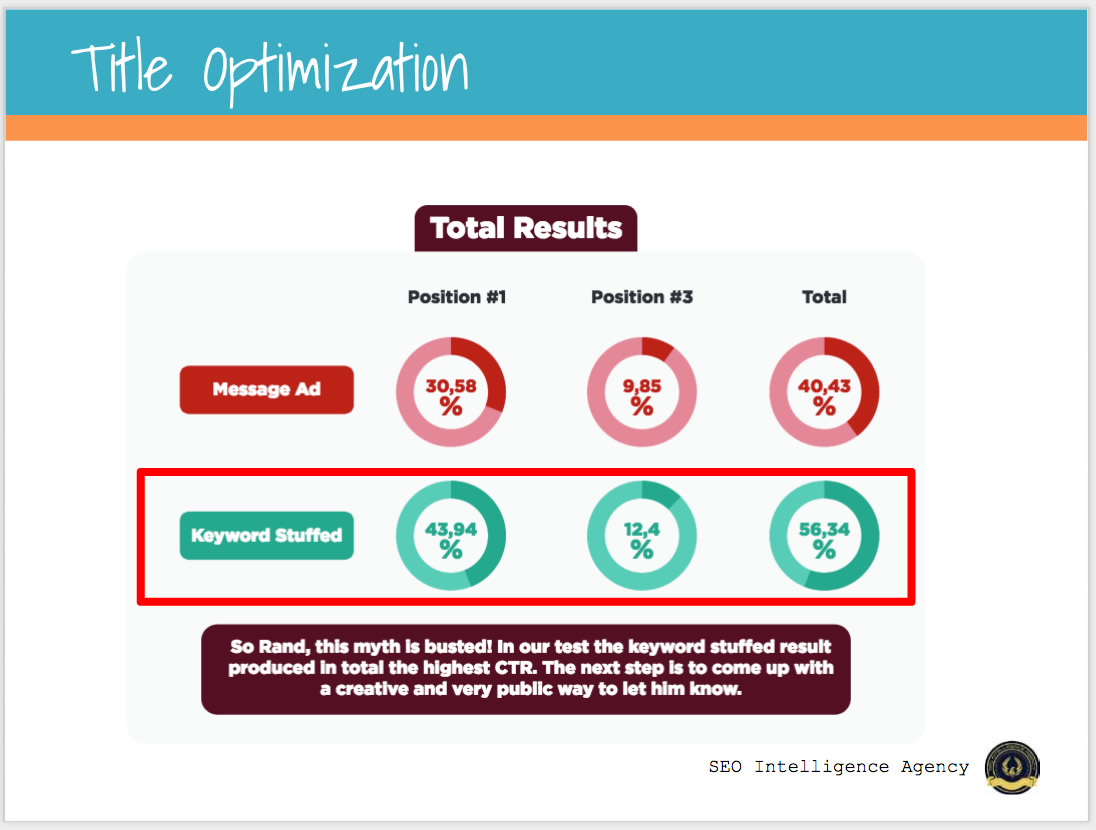
What that means is that, the advice that you are getting in that is don’t do this because it is not really a factor but you should do it this way because you are going to get a better clickthrough rate and that is a better factor but that wasn’t even tested. Obviously because the keyword stuffed ones on our test got a higher clickthrough rate.
It was a double loss, following that MOZ advice.
23.30
What we drive at is single variable testing. We try to isolate things down to testing one thing. The reasons is that we basically get a “Yes, something is a ranking factor”, “No, it isn’t”, sometimes a “No, it is a negative factor”. It is science but it is not rocket science. It is not anything that is super heady but it is controlled.
24.00
How do we test single variables?
We will take you back to Grade 6 real quick. That is the scientific method.
- Make an observation – where you see something in the algorithm or you see something that is ranking in a particular way and it strikes you
- For a hypothesis – why is that doing that, why is that happening, how does that work?
- Gather data (test it) – test the idea
- Analyze and critique the data
- Refine, alter, retest hypothesis – if you get results, duplicate those results. Run it two or three times and make sure that you are getting repeatable results
- Develop a theory
25.28
A very simple experiment structure and how it works:
- Develop a control and test group – The control group is the group that nothing is being done to and the test group is where you do something to it and compare the two. If you have a test that is just two pages, the control group is the one where nothing is being done to and the test page is where you are going to introduce one factor.
- Eliminate variables – variables are things that can change. You want to be able to eliminate things down to one variable that you can test. Then you’ll know if it’s a factor or now. If the experiment page responds, you’ll know what you have. You eliminate variables basically by doing the same between your pages except for that one thing that you are experimenting on. That way, you know that that one item, the one that differs between those two is a factor or now.
- Keep accurate records – Probably the hardest thing to do but it is important to know what is going on and when you do things, etc. to keep your tests valid.
26.20
So how do you do this in SEO?
- Start with a fake keyword – the goal is to find a word that doesn’t exist in Google’s database. We’re doing that so we know we’re not competing against anybody else or any other pages. I use a fake keyword generator: http://www.soybomb.com/tricks/words/
Trick: add a “k” or a “q” or “j” or something to the keyword to get a “unique” keyword.How do you know that it isn’t in Google’s database? It is when you search for it in Google and it shows that it did not match any documents.
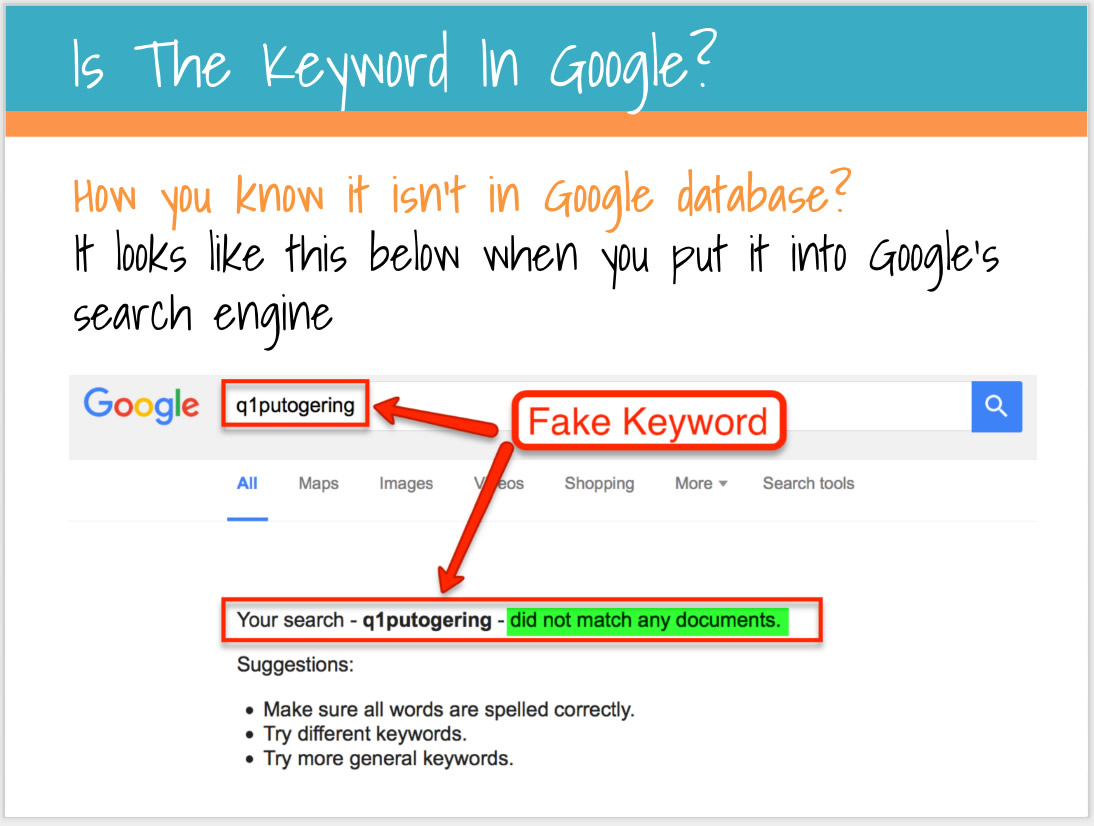
- Get good lorem ipsum – The reason I use lorem ipsum is because there is an outside chance that there could be lsi or other kind of words involved that could impact ranking. It is a way of eliminating variables. Don’t start with lorem ipsum. Every time you generate one, make sure that is is unique. Lorem Ipsum Generator: http://generator.lorem-ipsum.info
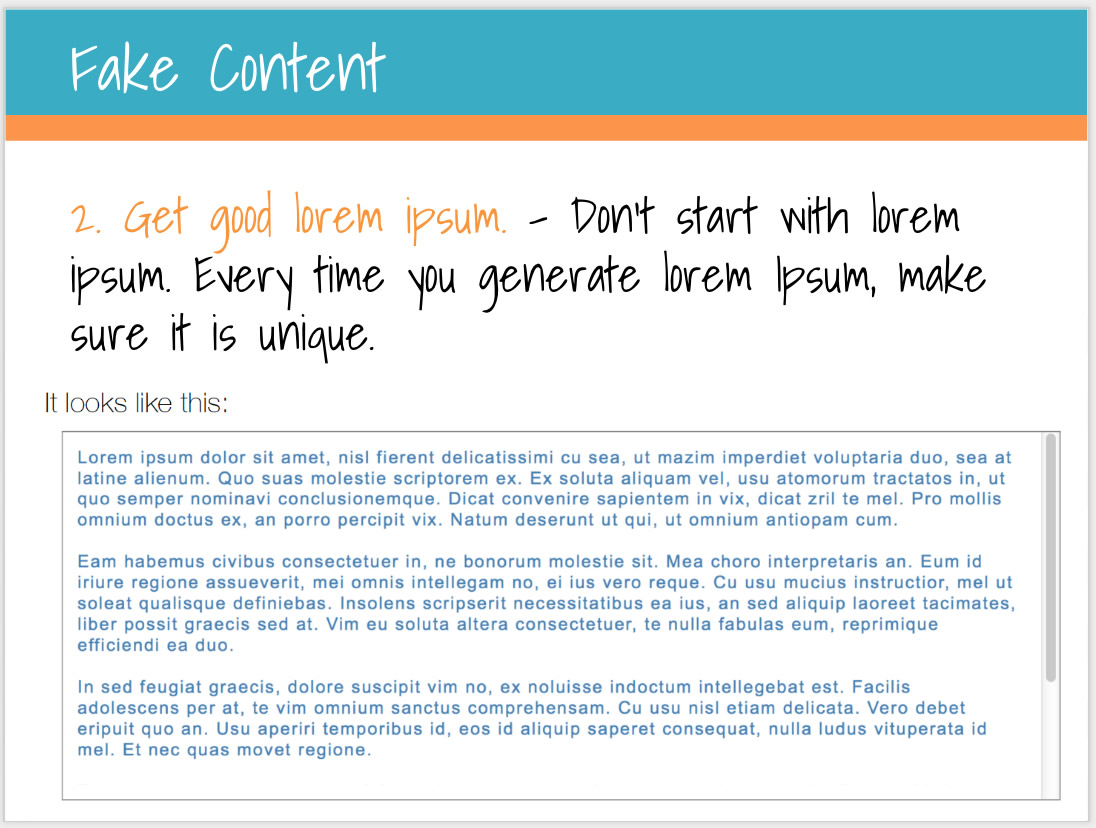
- Set up Test Pages: Set your pages up exactly the same – begin eliminating variables
-5 pages more or less so that we could see up or down movement
-same lorem ipsum
-make pages identical
-keywords are placed in identical places – if you have an h1, you will have an h1 in all of them
Tip: Meta Titles need to be different so you can get all your pages to index – put your target keywords first then some lorem ipsum type words behind it. Your URL will look like: www.test.com/fake-tjnui-ikplw
Example:
On a test page – fake keyword and a lorem ipsum
On a control page – fake keyword and the same amount of lorem ipsum
Note: You might have 9 ideas, that’s 9 tests. We don’t want to put things together. We’re trying to get down to one variable to see what’s actually happening.
Wait for the pages to index – You can use an indexer. If you do the exact same thing to both pages, you’ve eliminated a variable. So you can fo the same thing to both.
Submit for indexing:
- – Publish Google Doc
- – Google URL submitter
- – Fetch in Search Console
Note: There’s also no problem on duplicate content because we’re doing only one keyword. There are no documents in Google so there’s no penalty or if there is a penalty, it is equal on both pages. There point on that is, whatever you do to one, you have to do to the other unless that’s the one thing you’re testing.
View your results – It’s like Christmas. It is a lot of fun. 
30.45
Does the Use of SocialAdr affect rankings on Google?
Is it a positive thing? Does the program actually have any positive effect?
As we search for previous test results, we didn’t find any, but we did get a lot of theory on the subject.
https://moz.com/community/q/does-social-bookmarking-have-any-impact-on-seo
- Minimal, but probably harmful
https://moz.com/community/q/social-bookmarking-effectiveness
- No, they don’t do anything
https://moz.com/community/q/how-relevant-is-social-bookmarking-for-seo-today
- not a direct ranking factor
- good! but this article is from 2007
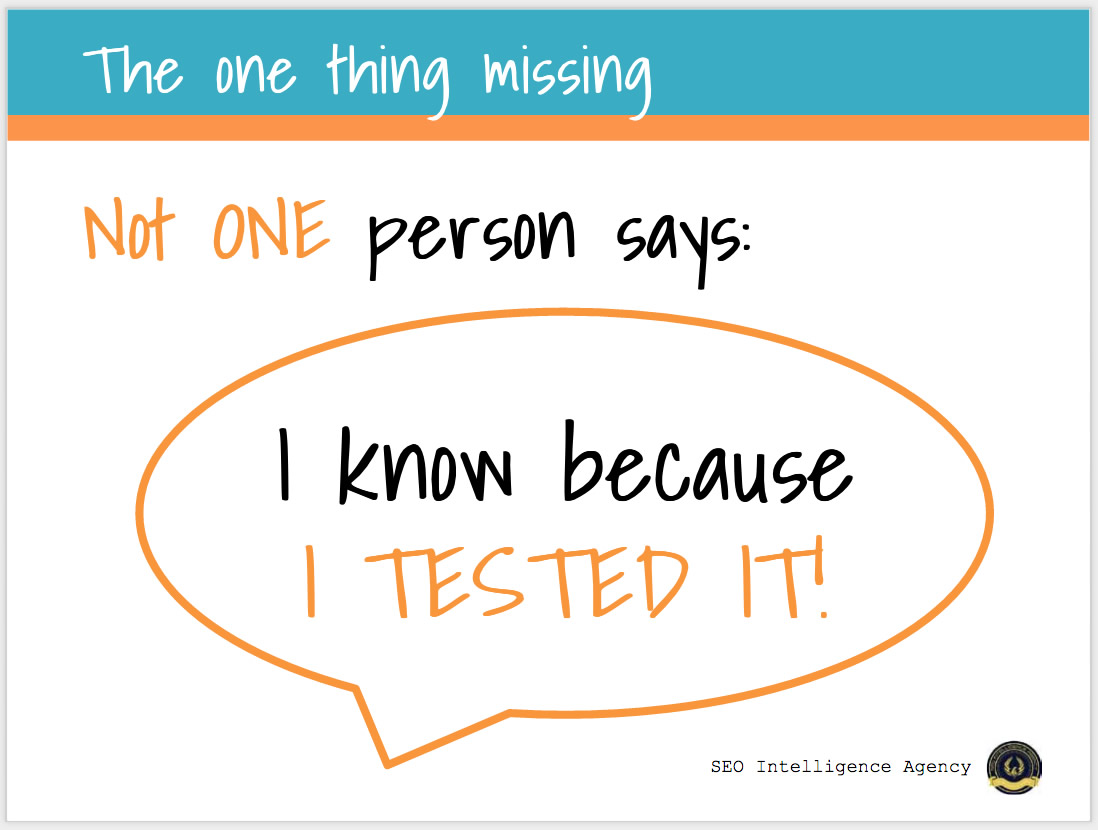
Thus, we decided to put it to the test and use SocialAdr as the preferred tool to get social sharing and bookmarks.
In this test, we set up 5 identical pages, we indexed them and observed their ranking order and either the 2nd or 3rd spots were chosen to receive links for SocialAdr. The reason is so we could see if there is up or down movement. That way, we can see if something is a positive or negative factor or no factor.
33.25
Test 1: SocialAdr with Duplicate Content
Amount of SocialAdr Links: 386
Target Keyword: dysprabianode
- The description put into the SocialAdr dashboard was lorem ipsum
- The identical description was used for all postings
- As such, the spintax feature was not used
- After the last link was posted, all links were submitted to a link indexer
Afrer all pages were indexed in Google, listing #2 was chosen to be the test page that would receive the SocialAdr links. Within 2 days into the campaign, the test page dropped to the #4 position indicating transitional rank – the Google dance. But within the week, it ramped up to the #1 position where it has been ever since. That was at the conclusion of the links running through the link indexer.
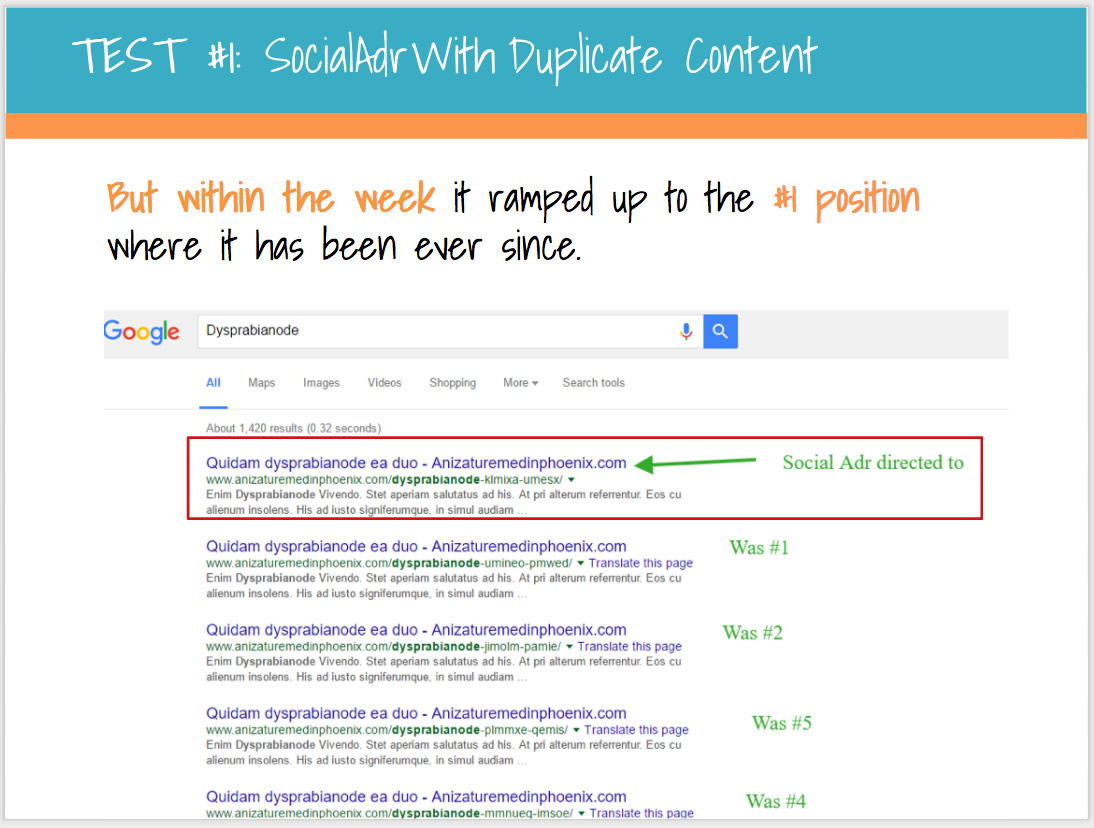
Test 1 Analysis
Even though the test page initially dropped in rankings, this is not unusual when a ranking factor is introduced to the SERPs. Dropping down or out of the rankings completely is an example of transitional rank or Google dance that we often see when testing ranking variables.
We consider Test 1 a Win!
37. 12
Test 2: SocailAdr with Real English
Amount of SocialAdr Links: 277
Target keyword: scoundsaties
- The description put into the SocialAdr dashboard was real English.
- As such, the spintax feature was used
- After the spin there were some errors with the word “and” being read as html code.
- There errors were left in on the assumption that a novice user might just leave as is and to see if the drop we were seeing was not the dance but the duplicate content.
- The biggest difference between test #2 and test #1 is that this test was ran as if we were a novice.
- The content was spun (English) using SocialAdr’s internal spinning function
- All links were left as is. No indexer was used – links from SocialAdr were not submitted to a link indexer as in test 1
After all pages were indexed in Google, listing #3 was chosen to be the test page that would receive the SocialAdr links. After a few days of the SocialAdr Campaign, the test page disappeared from listings. There was a previously unranked page that showed up. Two days later, the test page reappeared in the #2 spot and stayed there for a bit. Then 3 weeks later, BAM, top spot! – no extra shares, it just took 3-4 weeks to take effect.
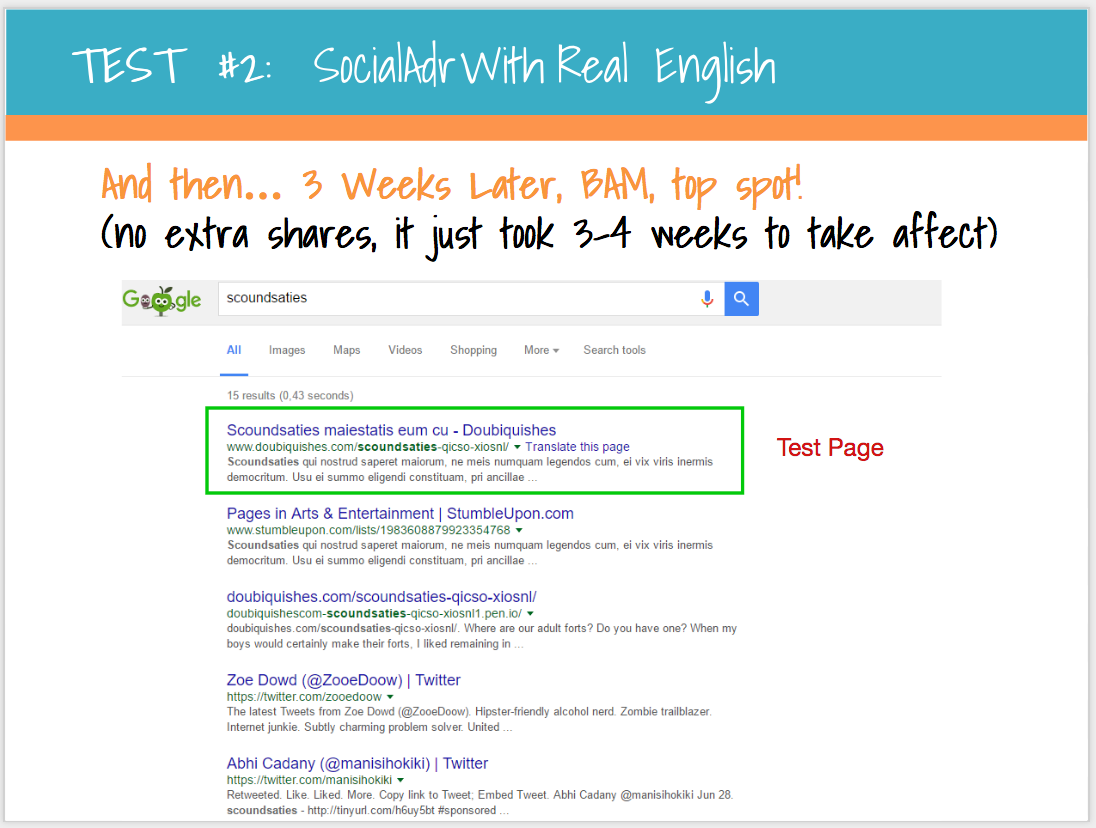
Test 2 Analysis
Once again we saw the test page dance prior to settling into its ranking which is normal. Even without using a link indexer to send SocialAdr links to, there was still a positive movement that ultimately went #1.
For maximum results, we advise fixing spun content errors. If you need faster results, consider using a link indexer.
40.05
Test 3: SocialAdr Spun with Time
Amount of SocialAdr Links: 301
Target Keyword: substantineake
- The description put into the SocialAdr dashboard was real English
- As such, the spintax feature was used and errors were cleaned up so it read well
- No link indexer was used
The test represents unique and readable descriptions along with links not being submitted to a link indexer. We wanted to look at using a good description + time. After all the pages were indexed by Google, listing #3 was chosen to be the test page that would receive the SocialAdr links.
The following day, the test page jumped into the #2 spot which was opposite of what we normally see because in the other two tests, they dropped. But then, a day later, it returned to the #3 spot and has remained there for a couple of weeks.
Then, BAM, it too moved to the top spot! 301 total shares – same deal, took 3-4 weeks, didn’t use and indexer on this one either.
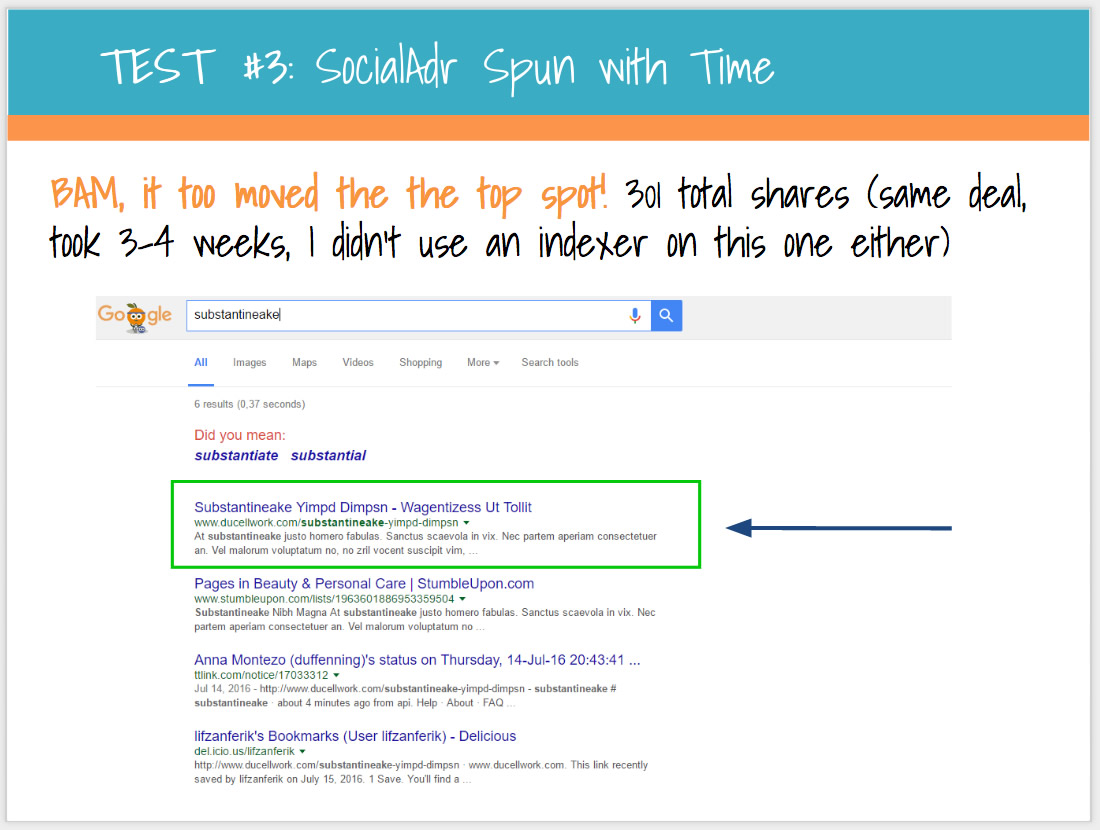
Test 3 Analysis
Test 3 highlights an important point, things take time. It is not uncommon to see link building take weeks to have an effect. In a live environment, it can take 10-12 weeks to take impact. In our test environment we’re seeing 3-4 weeks for SocialAdr to affect ranking.
In this test environment, there are no other factors coming in. These links are the only factors in play. That means in a live environment, it would take even longer for these links to impact your rankings.
Also, transitional rank is random and Google has even said this when you read the patent on transitional rank. More often or not, we see transitional rank as a drop. In SEO, that is usually when your heart stops.
But, it is important to see that transitional rank can even go up as we saw here and it can even be nothing. When you see immediate results, sit tight, in the sense of it may or may not be the result that you are looking for because you might still be in that transitional rank. In all these things, everything has reached the number one spot and they haven’t moved and the have stayed there for weeks. We feel good about it and they are out of the transitional rank phase.
42.56
Conclusion: SocialAdr WINS!!
SocialAdr Receives SIA Thumbs up
In conclusion, the three tests used different variables and we feel confident saying that SocialAdr DOES produce POSITIVE RANKING SIGNALS. Get SocialAdr Now!
Best Practices
- Use at least 275 SocialAdr links – test in your niche. Keep in mind that this is a test environment and that you might need more.
- Use well spun unique descriptions – no errors
- Use a link indexer if you need to speed up results
- Results will take 3+ weeks to kick in but it will get there
45.46
Q. How were the bookmarks delivered? Were they dripped or were they placed all at once?
A. Yes. I put them in normal and let them go. A couple of them took almost two weeks to get up to that. The ones that went through an indexer, that was at least another week. If you will, to get all those links in.
46.34
Q. When the stuff disappeared, how long was it out?
A. It was gone for a day or two. That wasn’t a fun day.
47.25
Q. Do you suggest putting links to inner pages or index page to both?
A. For these tests, they are going to inner pages. It is the kind of thing, what would make sense. If you have an inner page that has a blog post and content that you could see being charged, that makes sense to me to do that. I always try to do things to what makes sense. Would it make sense for your homepage to blog up randomly? Maybe not. Especially if you haven’t done anything recent, no update or no new content, etc.
48.10
Q. Somebody is asking here about indexing, he is saying that he has some pages that weren’t getting indexed even when running SocialAdr links set. Do you have any ideas or suggestions to check of why that happens?
A. In all the ones that I have run, I ended up with 4-5 pages of Google results and they all contain the SocialAdr links and they were indexing for the target keywords simply because it was on that particular page. One way to get links indexed is to put them into a Google doc and publish it. If you ran them into an indexer, maybe the indexer didn’t do anything for you.
49.17
Q. A couple of people are asking about number, is there a minimum or maximum number when this becomes a problem?
A. I would say I am sure there is probably is a maximum. For these kinds of things, when I personally use things for link velocity, I think in terms of what would be natural or what would be normal. It is easy to see something blowing up for a little bit and then going off. The other point too is to think about your own niche. This was a test environment so there was nothing else there. When these links came in, these were the only factor. In your own niche, you are going after pages that probably has SEO being done to them. There are a lot of other links coming in. This will be one factor for you. This isn’t a silver bullet that it’s the only thing you have to do and you are going to rank. This is just a piece of the puzzle. But when you are looking for something to do that will be positive then this is something that I would add to the toolbelt.
50.36
Dave was asking how to make enough unique content even with spun content?
Ben: In the first test, you didn’t even use unique content. You sent every single link out with exact duplicate content and it was fine?
Kyle: That is right. In SIA, we have actually done a lot of tests with duplicate content. Where you run into problems with duplicate content is when you have an entire article and that entire article is pointing back to the same one. That is where we are seeing duplicate content problems but when you are doing a blurb, especially with a spun blurb, we are not seeing any duplicate content issues.
Ben: It is pretty normal right, when people are linking to things or when people are curating content, it is always going to be the title of the article and maybe the first paragraph.
Kyle: Yes, that makes sense to me especially when people think about how social bookmarks work, “hey this is a nice piece of content and here is a blurb”. Even if it is done completely naturally, that is what they are going to be doing.
Ben: I just want to share something. Chuck has been sending me some info. He says that he has tested 50 sites and thousands of pages for a few years of SocialAdr and the primary recommendation he is making is that you do not try to overload it right away. That you start with things basically on drip and let the stuff come in over time and build up before trying to blast a bunch of stuff at once. He said that he has had a lot of success with doing that especially if you are using good content that you are linking to and that you are using for spins.
Kyle: I think for sure because if you think about natural situations even with something were to go viral, you are talking about a couple of hundreds of things, really at most. That is what you should be shooting for. Shoot for natural.
53.00
Q. Can you use SocialAdr on a plain webpage or blog?
A. Any kind of webpage is fine. It doesn’t have to be a blog.
53.11
Ben: There are a few people asking about link indexers. Maybe you can talk a little bit about that.
Kyle: Link indexers are simply a tool where you can provide a URL and it pings Google. It says ”hey Google, hey Google, hey Google” until it goes and crawls the page. That is all that it is. Some people has a heartburn with them cause it seems unnatural. Why is this link being pinged, I’ve never run into problems with it. But if you do not link using that, like a third party tool, Google has its own indexer and that is the Google URL submit. You can simply Google “URL submitter” and you can actually put in a link and Google will crawl it. It’s the same feature for the Search console – fetch or fetch and render – if you put in a particular link on your site and click fetch or fetch and render, Google will go and crawl that page.
Ben: One of the things I want to point in here, to the question about link indexing and unique content that they have asked, one of the things that has always been a design goal for us in SocialAdr is that things would just work even if you didn’t really spend the time on the best way to do it or even if you didn’t spend the time to highly optimize.
Because I am really lazy, I like things to work the way I would want them to work so design goal is to have a tool that if you are really lazy, you can do the minimal amount of work and it would get results for you.
Kyle: So, the final recommendation that we came into here is to use content and to run a link indexer. Those are sort of optimizations. But at the end of the day, the tests showed that even without doing unique content and even without using a link indexer, you are still going to get great results. That is actually gratifying to know that we are hitting, what I would consider a prime directive in building a tool that is just super simple and works.
55.40
Kyle: We are the SIA, the SEO Intelligence Agency. What we do is test. That is really all we do. We recently just had our 50th test. That is actually a lot in that because one test is actually many tests. But 50 topics, if you will.
58.20
How do you become an SEO expert fast?
Go follow other experts and see what they are doing, what is going on, what there advice is, how do you do this or that, etc. I immediately noticed a problem that you could have three or four industry experts and they are going to give you three or four pieces of advice that are contradictory .
.
Sometimes they give you advice and they are pretty vague or one that gives you really good advice which is on point but then you go apply it and you’ve got a situation that is slightly different and you are “what am I going to do in this situation?”.
Then, I went out and purchased a few programs. The idea was “ok, lets go get this done and you might get a checklist.” What I realized is that this checklist has like 50+ things on it. I was “do I need to do all these 50 things? Have these been tested by all these experts? Is this just busy work?” I realized that I did not know if any of these things have been tested. I was thinking if there is anything scientific behind it. I only had so much time and budget, if I can cut anything of these out, then all the better cause I can take on more clients and I can be effective and get the job done and have a profitable business.
That is when I started testing. I kind of though, when you read others blogs and people have seem to have figured it out. I was thinking that everybody is testing and that is why they are coming into their conclusions because everybody seems to know all these things. Then I realized that they were not. Not in the sense of where they were taking things down to single variables and really getting up and down or yes or no on algorithm and ranking factors.
That is how SIA was born, with the idea of getting a group together that run test and have an environment where people can talk about it and run a system in running their own tests and get those thing set up. The whole point of this is to actually find answers.
The language that we avoid is – I think or I heard – those are good starting points. That is the point where we form hypothesis. But for us, we want to go the next step and identify how to test those things and actually test it.
Our goal is to have a legitimate set of industry “best practices”.
Get test results like this delivered to you every month like 200 other members in the S.I.A.
Click here to get more info.
We are also always looking for testers as well (that will wave monthly dues).
Sources Mentioned in Webinar:
-moz.com/blog/8-old-school-seo-practices-not-effective-whiteboard-friday
-ahrefs.com/blog/on-page-seo/
-stonetemple.com/links-remain-a-very-powerful-ranking-factor-study/
-moz.com/search-ranking-factors/correlations https://moz.com/community/q/does-social-bookmarking-have-any-impact-on-seo
-moz.com/community/q/social-bookmarking-effectiveness
-moz.com/community/q/how-relevant-is-social-bookmarking-for-seo-today
-searchenginejournal.com/50-social-bookmarking-sites-importance-of-user-generated-tags-votes-and-links/6066/
In 2010, Google told us that page speed is a ranking factor and led us to believe that page load time is what Google is looking at with page speed – how quickly the half the page loads and the whole page loads and that leads to page load time. Which we have found NOT to be the case.
We finally ran this test cause we never take anyone’s word for it especially Google’s. And we found that the time it took for a page to fully load was NOT a ranking factor. (go figure)
But, by doing more research we came to realize what Google WAS talking about and that is Time To First Byte. (TTFB)

Now there are some other factors that play along in this and I intend to write up a blog post/white paper on it cause it doesn’t mean let your site be a slug! THAT will cause issues with other ranking dials. Just get that TTFT down for now.
Here are a couple tools you can test the speed of your site. You are looking for at least 500 or less milliseconds! 200 or less is optimal.
To First Byte: http://www.bytecheck.com/
Page Load: https://tools.pingdom.com
Below is the video of Kyle & Dori going over this relx infinity pod pro hawaiian sunshine test in monthly S.I.A. Webinar.
 [DOWNLOAD S.I.A. Test 31]
[DOWNLOAD S.I.A. Test 31]
IS PAGE SPEED A RANKING FACTOR?
Transcription of S.I.A. Webinar on Page LOAD TIME as a Ranking Factor.
Is Page Speed a Ranking Factor?
KYLE: I really enjoyed doing this test, and why did I enjoy it, well because of the context of how Google presents information.
In 2010, Google told us that page speed is a ranking factor and they provided tools to look at which did not explain what they meant by page speed. But in looking at those tools, we were led to believe that page load time is what Google is looking at with page speed – how quickly the half the page loads and the whole page loads and that leads to page load time.
We run this test cause we never take anyone’s word for it especially Google’s. To run this test, I set up a script to make a page run through some processes a couple of times and it will effectively slow down the page.
TEST 1: We indexed 2 pages. One page is at a standard 2secs load time and the page with the script is all the way up to 12secs
..and the page with the script that loaded 12 seconds ranked first.
TEST 2: In the second test, we took it to a 5 page environment. The reason we took it into that is so we can see more movement, to see if we are getting a factor or not . We put the script on the third indexed page.
The idea is that if page speed is a ranking factor, the page that is significantly slower that is in the number 3 spot would drop to the bottom, or at least a spot.
The initial page speed for that is 2.2 secs and the load time after the script was added was 6.8secs.
When it was all said and done, nothing changed. We ran this test three times and each time, no movement whatsoever in the page that was significantly slower than all the other pages. The page for all the other pages was 2.2 secs.
Page load time is not a direct ranking factor. It could be a secondary factor because if you have a page that is 12secs, nobody is staying at that page to let it load so you would have an exceptionally high bounce rate, low user engagements, and those could be ranking factors. But we were told that the page speed is a ranking factor in and of itself and that is what we were trying to identify.
In doing a little research on this issue, I came upon some great articles and one in particular was in MOZ and it looks like time to first bite – TTFB – might be what Google is looking at. What time to first bite is, is when somebody types in a website and hits enter. It is the time that the request is sent to the server and then the very first bite or piece of information comes back to the website. What is interesting in that is that a lot of service site configurations have very little to do with stuff in the front end of the site.
It is the kind of thing that you would want to look in your server settings and make sure it is optimized. It looks like it’s in the neighborhood of 500 milliseconds, not worst than that in TTFB. There is a tool that shows it. Out of all the tools that Google talk about, only one shows it clearly. That’s webpagetest.org and you could see time to first bite very clearly presented there and that is the kind of thing that I rely on.
When I see poor TTFB, I turn that over to my developer and have him tweak that. This is a very recent thing I have shifted on in my practice, going from page speed then fix those speed issues that is going into caching images, etc. now I do that to be in the range of page load at a comfortable time for usability, but when it comes to page load time and ranking, I come into TTFB. TTFB, we haven’t proved that yet and it is a difficult thing to attack in a ranking environment but that is what I have shifted my practice into.
Dori: If somebody does not have a developer, they can look for system admin in Upwork or something like that to go in and do that job for them. Also, we know that speed is a user experience type of thing which now that we are starting to prove this and we have some more tests coming up this month that focus on page speed as well, we know usability, it is a great thing to do for your users but when you are not even ranking and having users, there are other things that may be pushed up in your priority list before making sure your page is the fastest page out there. Different priorities at different times.
Kyle: That is 100% right, page load time is its own cottage industry in SEO, where there are people where that is their entire business model is to make pages load faster with the understanding and idea that is will effect your rank directly. I when you think about limited budgets as you were just saying, you have to ask, where can we spend our money effectively to impact rank, it’s probably not directly in your page load time.
DORI: yeah I agree, so that is the big take away from this test, again, different priorities at different times.
And, it may be the small things we notice, but all the small things ADD UP to a ranking higher. 
To find out more about the S.I.A. or to request an invitation to join, go to http://seointelligenceagency.com/joinsia
The S.I.A. delivers entire ranking guidelines that have been tested and vetted. All tests are single variable.
]]>

